- How to setup your software
- Sample MLA Paper – normal paper
- Sample MLA Paper – has cover page
- Sample APA Paper
- Sample Chicago Paper
- Sample CSE Paper
- APA Format Guidelines
- MLA Format Cover Page
The Modern Language Association (MLA) does not require you to create a cover page when you complete your research paper, but some instructors may require it.
If your instructor requires your paper to have a cover page, here is how to make it (very easy). This cover page should include: your school name, your research paper title, your name, your class, your professor name and your paper due date.

How to Format Your MLA Cover Page:
- This page is double spaced and the letters are centered.
- Font: Times New Roman
- Font size: 12
- The first letter of each word should be capitalized with the exception of very short words such as: the, and, of, or, a, an, in, to, for. Note: the first letter of the first word should be capitalized, regardless of what kind of word it is.
- Type the name of your university or college.
- Skip to about one-third of the page and type your research paper title, include a subtitle if you have.
- Skip several lines down and type your name, your course name and number, your instructor name and your paper’s due date.
Sample MLA Format Cover Page:

Sample MLA Format Cover Page
Alternate First Page:
If your instructor requires a cover page, you would omit the main heading on your first page. Here is an example of the first page if a cover page is used. You still need your last name and page number on the first page and every other page.

Sample MLA Format First Page with Cover Page

Sample MLA Paper:
Visit here for a sample paper with the cover page. The cover page can vary slightly. This paper also has the outline page for your sample.
If you find this website useful, please share with a friend:
How do I get the header on the second page on down? I tried editing it but then it takes the header away from all the pages.
In word select the header then go to: Header & Footer>Page Number>Format Page Numbers>Page Numbering>Start at page>Set to 0
How do I get the header on the second page on down? I tried editing it but then it takes the header away from all the pages. I am using windows. Also, the page numbers are not working for me either. Please help me.
How should I start the page after my cover page?
https://mlaformat.org/mla-format-heading/
Thank you so much Stephen !!! Helped a lot in my written assignments 🙂
Great site ! Thank you so much. Just returned to school to complete my bachelors and needed a little refreshing. Has all the information I needed !
Thanks so much for all of the great information! I have not used MLA before and was a little panic stricken. I have found all of my answers here. This is now saved to my favorites so I can use it regularly. Thanks again!
Should the lines on the cover page be double spaced?
Thanks so much for the picture of the cover page it has helped a lot. But, I was wondering do I still need to put my Title at the top of every page after the header?
Hello Lydia. You do not.
After your cover page, your next page’s heading should look like the “Alternate First Page” above.
After the “Alternate First Page” => your next pages should have “The Inner Pages” heading: https://mlaformat.org/mla-format-heading/
Sample paper: https://mlaformat.org/mla-format-sample-paper-with-cover-page-and-outline/
hey Lydia you don’t need to but if you want to you can
Thank you so so much. I love the simplicity of the website, very easy to understand. I finally have a cover page for my paper!!
I love this website!! It helped so many times with all my essays. I’m working on a college one and this was very useful. Thank you soo much. And thanks for the examples im a visual person I needed that 🙂
Hi Kaylin, I am glad you find this site useful. Take care!
By the way (sorry i forgot!) for the coverpage, would the text font be 12 times new roman???
You can set everything 12, Times New Roman. Or you can set the Title a little larger than 12, that should work too.
In the example above, I have the title larger than 12.
Here is an example with everything set at 12.
Thank you so much for your help on this useful website! I found it very organized and I’m very glad that I came across this particular article. Thanks!!!!!!!:)
I have a question regarding the cover page and the following pages. If I have a cover page as the example provided, do I still need the heading on the next page? And should the pages after that contain my last name on the top left as the header does on the on the previous pages? or do I not need the header at all if I have the cover page and just my name?
Excellence question, Stella! I have updated this article with information on the first page if a cover page is used. Please see “Alternate First Page” above.
You can omit the main heading but you still need your last name and page number on the first page and all subsequent pages. Take care!
Leave a Comment
Current ye ignore me @r *
Leave this field empty
Next post: MLA Format Heading
Previous post: MLA Format Websites
- The Format of the Research Paper
- MLA Format Headings
- MLA Citations
- MLA Format Works Cited
- MLA Format FAQs
- MLA Format Sample Paper
- MLA Sample Paper w/ Cover and Outline Pages
HOW TO SETUP YOUR SOFTWARE
- MLA Format using Google Docs
- MLA Format Microsoft Word 2016
- MLA Format using Pages on Mac
Copyright © 2011–2024 • MLA Format • All rights reserved. Currently, MLA is at its 8th edition. This website has no official relationship with the Modern Language Association and is not endorsed by the MLA.
Home / Guides / Citation Guides / MLA Format / Creating an MLA title page
Creating an MLA title page
If you are writing a research paper in MLA style 9th edition for a class, then you may need to include an MLA format title page. An MLA title page is the cover of your paper, and they aren’t always required. So, how do you make a title page that adheres to the MLA formatting guidelines, and how do you know when you need one?
This page contains all the information you need to know to make the perfect MLA title page, so that you can prove that you are an expert researcher and get the best possible grade. This MLA sample paper will show you how the rest of your paper should be formatted.
Here’s a run-through of everything this page includes:
Title page vs. MLA heading on first page
Title page / cover page, first page: mla heading (no title page), troubleshooting.
The current edition of the Modern Language Association (MLA) handbook does not require a title page , but your teacher, professor, or other reader may require one. In this case, you will need to know the differences between a title page and an MLA heading, and which one to use depending on your reader’s preferences. Other citation styles look slightly different, like this APA title page .
A title page, or a cover page, is a single page that comes before your MLA abstract (if required) and the content of your paper. It introduces your paper and quickly shows a reader the following information about your paper:
- author name (your name, since you wrote the paper)
- course information (if applicable)
It does not include any of the research paper itself.
First page with MLA heading
MLA format recommends adding an MLA heading to the first page of your paper. This contains the same information as a title page, but the information is formatted differently and is on the same page on which your actual research paper begins.
Unless otherwise specified by your instructor or teacher, this should be how you format your first page.
Before you start typing your MLA research paper title page, you will need to gather some information.
What you will need
If you are creating an MLA heading on the first page of your essay instead of a title page, you will need most of the same information, but you will format it differently.
To create a title page, you need to include:
- The name of your high school, college, or university (if applicable)
- The title of your paper
- The subtitle of your paper (if you have one)
- Your first and last name
- Your teacher or professor’s name (if applicable)
- The class name or course number (if applicable)
- The date the paper is due (in “day month year” format)
Formatting guidelines
Follow these formatting guidelines when typing your MLA title page:
- Double-spaced
- Times New Roman font
- Size 12 font
- The first letter of each word should be capitalized, with the exception of very short words such as the, and, of, or, a, an, for, in , etc. However, the first word should always be capitalized.
- Do not include a page number heading on your title page
Step-by-step instructions
Here are the steps you need to take to create the perfect MLA title page:
- At the top of the page, type the name of your high school, college, or university (if applicable).
- Skip down approximately one-third of the page and type the title of your research paper using title case.
- If you have a subtitle, type it on the line following the paper title.
- Skip down to the bottom third of the page and type your first and last name.
- On the following line, type the course name and number (if applicable).
- On the following line, type your instructor’s name (if applicable).
- On the following and final line, type the due date of your paper in “day month year” format.

Although it’s important to know how to create an MLA essay title page in case your instructor requires it, in most cases you will use an MLA heading on the first page of your paper instead.
Remember, you should only create a title page if your instructor requests it .
Otherwise, use these guidelines to create an MLA heading. If you create a title page, then you usually won’t need an MLA heading on your first page, but you should ask your instructor for their specific requirements.
To create an MLA heading on your first page, you will need to include some of the same information you would use for a title page, including:
- Left-justified text for MLA header
- Centered text for title
- Right-justified text for page number header
- In the top left corner of the first page of your essay, type your first and last name.
- On the following line, type the due date of your paper in “day month year” format.
- On the following line, switch from left-justified text to centered text and type the title (and the subtitle on the same line, if you have one) of your paper in title case. Do not italicize, underline, or place your essay title in quotation marks. Do not use quotation marks unless you are referring to other works in your title and need to enclose the referenced works in quotation marks.
- Your research paper should begin on the following double-spaced line.
- Create a right-justified text header one-half inch from the top of your paper that includes your last name and the page number.
- All pages of your paper should be numbered with your last name and the numerical page number. The page including your MLA header, title, and the beginning of your essay is page one (1).
- Your instructor may specify not to include a last name and page number header on your first page. Always follow your instructor’s guidelines.

Solution #1: What should I do if my paper is a group project?
If you have written a collaborative paper with multiple authors, list each author on your MLA title page or in your MLA heading in alphabetical order, with line breaks between each.
If your paper has multiple authors, omit the name from your page numbers in the upper-right corner of your MLA-format paper.
Example MLA heading for a group paper:

Example MLA title page for a group paper:

Solution #2: What should I do if my paper isn’t for a specific class?
If your paper is a thesis project for your degree, for example, or not for a specific class, you can omit that information from your MLA title page or MLA header.
Solution #3: Does my paper need a subtitle if I use a full MLA title page?
While an MLA title page allows for a subtitle beneath the title of your paper, it is NOT required to have a subtitle or make one up for your MLA title page.
If you didn’t intend to have a subtitle for your paper, there is no need to add a subtitle. Just leave that area of your MLA title page blank.
Solution #4: Will my MLA title page be part of my final page count?
A title page is not typically included in a paper’s final word count. Check with the teacher or professor assigning the paper to be sure, but it is highly unlikely a title page will count as a full page of your final paper.
Published October 25, 2020. Updated June 4, 2021
Written by Grace Turney , freelance writer and artist. Grace is a former librarian and has a Master’s degree in Library Science and Information Technology.
MLA Formatting Guide
MLA Formatting
- Annotated Bibliography
- Bibliography
- Block Quotes
- et al Usage
- In-text Citations
- Paraphrasing
- Page Numbers
- Sample Paper
- Works Cited
- MLA 8 Updates
- MLA 9 Updates
- View MLA Guide
Citation Examples
- Book Chapter
- Journal Article
- Magazine Article
- Newspaper Article
- Website (no author)
- View all MLA Examples
How useful was this post?
Click on a star to rate it!
We are sorry that this post was not useful for you!
Let us improve this post!
Tell us how we can improve this post?
The title page in MLA style gives basic information such as the name, the instructor’s name, the course name and number, the title of the paper, and the submission date. MLA style does not recommend using a title page unless specifically requested by your instructor; instead, it suggests creating a header.
The difference between a title page and a header in MLA style is that a title page appears as a page on its own before the main paper copy. A header, on the other hand, appears on the same page where paper copy begins.
Include the following elements on a title page. Follow the order as given below.
The university name
The title and subtitle of the paper
The course name and number
The instructor’s name
The submission/due date
If you are not required to create a title page, and only need a header, the following elements should be included in the header, in the order as listed:
While MLA does not generally recommend the use of a title page, some courses or professors may require it. The title page should include the university name, title of the paper, your name, the instructor’s name, the course name, and the submission or due date.
Formatting title page
MLA style does not have any specific guidelines for formatting a title page. However, you can use the below suggestions to format your title page if you are required to create one for your paper.
Page margins
All margins (top, bottom, left, and right) should be set at 1 inch.
The font should be clear and easy to read. A good option is Times New Roman font in size 12 pt.
Text on the title page should be double-spaced.
Elements of a title page
Include the following elements on the title page. Follow the order as given below.
Add a few blank lines before and after the title of the work. The title should be in title case and centered.
Beginning on the title page, the paper should also include a running head. The running head includes the your last name and the page number. This should be placed in the “header” area of the paper so that it is present on each page. Use the page number feature in your word processor so that the page number is generated automatically.
Example title page
Chegg University
Relationship Between Students and Their Teachers
Ishithaa Gopi
Psychology 127
Professor John Smith
21 September 2021
MLA Citation Examples
Writing Tools
Citation Generators
Other Citation Styles
Plagiarism Checker
Upload a paper to check for plagiarism against billions of sources and get advanced writing suggestions for clarity and style.
Get Started
Still have questions? Leave a comment
Add Comment
Checklist: Dissertation Proposal
Enter your email id to get the downloadable right in your inbox!
Examples: Edited Papers
Need editing and proofreading services, how to create an mla title page | format, steps, & examples.

- Tags: Formatting Guidelines , MLA , MLA Style
If you’re writing an MLA-style paper for your class, you may need to include a title page or a cover page before the body. While the official MLA 9 Handbook does not mandate a title page, you should include one if your professor asks you to or you’re working on a group project.
In this article, we’ll break down the MLA format title page (also known as an MLA cover page). It’s always easier to just learn from samples, so we’ve included some great MLA title page examples!
When to use an MLA title page
An MLA title page is usually required for formal research papers, essays, and other academic assignments. It is also used while writing dissertations , graduate theses, and other extended works. A title page in the MLA format may not be necessary for shorter assignments or in-class essays.
If you’re unsure about whether your assignment needs an MLA cover page, consult with your professors or check your university’s guidelines.
What goes in an MLA format title page
An MLA format title page typically includes the following elements:
- Author’s name
- Professor/instructor’s name
- Course name
- Title of the paper
- Date of submission
For bigger projects or papers that you plan on submitting to journals, you may also need to include your university’s name on the title page. Just to be sure, it’s advised that you check the journal’s submission guidelines for a detailed list of elements to include in this section. For reference, you can also look up samples or check the publication’s previous editions.
MLA title page formatting guidelines
The MLA Handbook specifies important formatting guidelines you must follow while creating a title page. Refer to the guidelines below while writing your MLA cover page:
- Double-space all the elements on the title page.
- Do not include a header on the title page.
- Use the same font type and size you have adhered to throughout the paper (preferably, 12-point Times New Roman).
- Align each element (except the paper title) with the left margin.
- List the information in the following order: 1. Author’s name 2. Instructor’s name 3. Course name and details 4. Date of submission 5. University name
- If there are multiple authors, list each of their names in separate lines.
- In the center of the page, center-align the title of your paper.
- Use the title case while writing the title of your paper.
- Italicize names of media such as books, films, and TV shows.
If you don’t need to include an MLA cover page, you will have to include a title section in the top half of your paper’s first page. The formatting guidelines for this are largely the same as the title page, except that the title is center-aligned in the line following your name and credentials.
Since this is the first page of your paper, you’ll have to add an MLA header in the top right corner of the page. Here’s how the page should look:
How to create an MLA title page on MS Word
Students no longer have to manually format their academic papers and can rely on the blessings of Google Docs and MS Word. These word processors come with built-in templates that automatically format documents according to the MLA style. You can use these features to format your title page as well as the rest of the research paper.
Follow these steps to write a title page in MLA format:
- Launch Microsoft Word and open a blank document.
- Under the “File” menu, click on the “New” tab.
- Use the search bar and type “MLA” to find a sample template.
- Select the template that corresponds to your document type (research paper, essay, etc.).
- Check the preformatted document to see if it largely matches your university or department’s style guidelines.
- Replace the placeholder text in the document with your paper’s information.
- Cross-check what you have with your guidelines once again and fill in additional details that the template may have missed.
- Save your document and continue to add the rest of your text.
MLA title page examples
The guidelines we’ve laid out give you a general overview of the MLA title page format. Whether you’re working on a paper, essay, dissertation, or journal article, you will be required to adhere to these conventions.
The format required of you may vary from the standard MLA cover page depending on the university guidelines or submission rules. To make it easier for you, we’ve put down some MLA title page examples that you can refer to while formatting your paper.
MLA title page example: Two authors
1. MLA cover page with two authors
2. MLA title section with two authors
MLA title page example: Three or more authors
1. MLA cover page with multiple authors
2. MLA title section with multiple authors
If you need experts to review your paper, our paper editing services are at your… well, service! Meanwhile, here are some resources to help you learn more about the MLA style and academic writing:
- How to Cite Sources in the MLA Format
- MLA Citation Examples: Essays, Websites, Movies, and More
- How to Write an MLA Essay Header
- How to Write a Research Paper: A Step-by-Step Guide
- Research Paper Outline: Templates & Examples
Frequently Asked Questions
Should i include a title in an mla format paper, should the mla title page be double-spaced, should the mla title page be numbered, where should the mla title page be placed within the paper, what goes in the mla title page.
Found this article helpful?
Leave a Comment: Cancel reply
Your email address will not be published.
Your vs. You’re: When to Use Your and You’re
Your organization needs a technical editor: here’s why, your guide to the best ebook readers in 2024, writing for the web: 7 expert tips for web content writing.
Subscribe to our Newsletter
Get carefully curated resources about writing, editing, and publishing in the comfort of your inbox.
How to Copyright Your Book?
If you’ve thought about copyrighting your book, you’re on the right path.
© 2024 All rights reserved
- Terms of service
- Privacy policy
- Self Publishing Guide
- Pre-Publishing Steps
- Fiction Writing Tips
- Traditional Publishing
- Additional Resources
- Dissertation Writing Guide
- Essay Writing Guide
- Academic Writing and Publishing
- Citation and Referencing
- Partner with us
- Annual report
- Website content
- Marketing material
- Job Applicant
- Cover letter
- Resource Center
- Case studies
)
Title page in MLA style
Published October 22, 2020. Updated November 14, 2021.
A title page, or cover page, is like a book cover for your assignment. It provides the most basic details about your assignments, especially those which aid in identification. In that sense, a title page sets the stage for your writing and is related to the overall presentation of your paper.
A title page is not a compulsory element of the MLA system and is only added when specifically required. This means that in most cases, you will not create an MLA title page. You only create one if your instructor or institution requests a title page and specifies the format requirements.
For help writing your essay, research paper , or other project, check out these writing tips .
Title page vs. MLA heading
You should not confuse an MLA title page with the MLA heading. The MLA heading appears at the top of the first page of an MLA formatted paper and contains similar information to a title page: your name, instructor’s name, class or course name, and date. Both also come before the main paper copy.
The main difference between a title page and an MLA heading is where and how it is formatted. A title page is on its own page before the main paper copy, centers the text, and spreads the text throughout the title page. An MLA heading appears on the same page on which the main paper copy starts, the heading is aligned to the left, and it only appears at the top of the page.
For more information on how to create headings, refer to the MLA heading guide .
MLA title page format
Although the MLA system does not have a set format for creating title pages, there are certain basic rules and format settings that you can use to create a title page.
The title page will follow much of the same paper formatting rules that the rest of the paper follows. This includes the following:
- 1–inch margins around the page
- Your last name along with the page numbers on the top right corner (Running head)
- 12 pt. font that is easy to read
- Double-spaced lines
- Center-aligned text on the title page (the rest of the paper is left aligned)
The following details are presented on a title page, mentioned in order from top to bottom:
- University Name
- Title of Paper
- Course name and number
- Instructor’s name
University name
The university name is mentioned at the top of the title page. If the university name isn’t available, you can leave it out because this is an optional element (unless instructed otherwise).
If your affiliation is not with a traditional university/academic institution, you can simply write the organization where the following document is going to be submitted or the organization that the document represents.
Title of paper
This is the key element of the title page. It is placed around the middle of the page, about one-third of the way below the university name.
Ideally, the title should be short and crisp – it should directly address the topic and concern of the paper. The first letter of each word is capitalized, barring the small words, which are usually articles (a, an, the) and short prepositions (of, on, in, to, etc.).
The title uses the same font and font size as the rest of the paper. It should not be bold, italicized, or underlined. There is no need to add quotation marks around the title. However, if your title contains quotes, then only that part needs to be inside double quotes. Similarly, if your title contains the name of a body of work or text, that part needs to be in italics.
Adding a witty title to your paper instantly improves engagement. However, these might not provide sufficient information about the paper. In this case, the title is followed by a subtitle, written directly below it. In the example below, note that the main title is a quote from the book:
“Dorothea Is Not Always Consistent”:
Analyzing Dorothea’s Changing Desires in George Eliot’s Middlemarch.
Place your name about 4-7 lines below your title. It is presented near the bottom of the page, above the rest of the details. Write your full name, first and last (and middle initial, if you like). Do not present any other details.
The course name and number follow your name. You need not present the full course name; the official abbreviations can be used.
- Intro to Psychology
- American History
Instructor’s Name
Place their name after the course name and number. Use your instructor’s preferred name designations (Mr., Ms., Dr., Professor, etc.) and use their full name. If you’re unsure, check your class syllabus or ask them what they prefer.
Finally, the due date is written below the instructor’s name. This can either be the due date for submitting the paper or the date of submission. Write in the following format:
- Day Month Year
- 7 September 2016
Keep in mind that the title page, or cover page, is only a single page. Arrange the details in a manner that none of the details run over to the next page. You can start numbering your assignment from this page onwards. At the end you will find a Sample Title page, created using the MLA system. The details and format settings for a title page can vary, as it is not a traditional element of the MLA system. So be sure to ask for specifications.
Template:
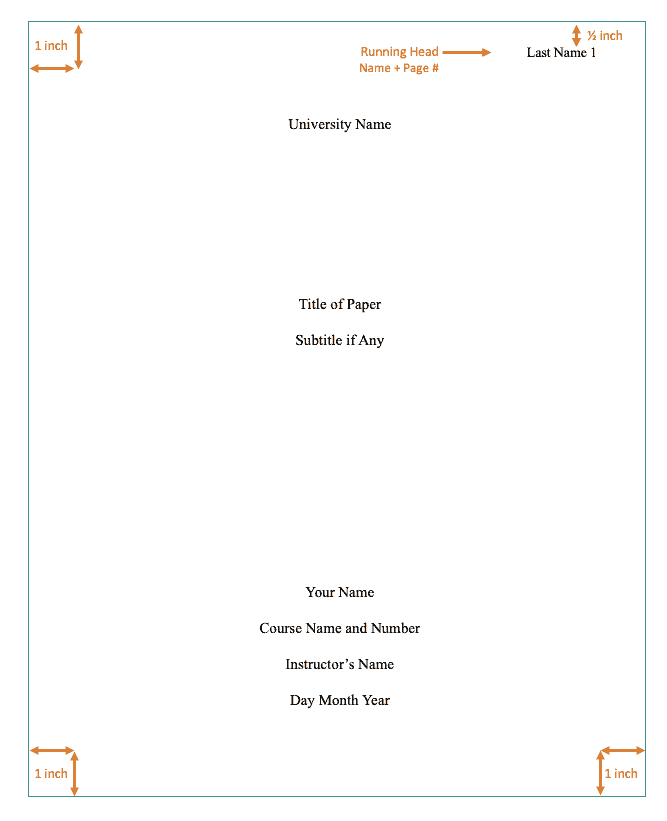
MLA heading
Usually, the MLA format presents these details on the first page of the paper as a heading.
From the top left corner, write the following in order, each on its own line:
- Your instructor’s name
Starting with the first line of the paper, indent half an inch from the left margin. There are examples below to help.
After the due date, on another line, write the title of the paper and center it. The title should be plan and not be bold, underlines, or italicized.
On the next line after the title, begin your paper. The text should be left-aligned. The first line of each paragraph should be indented by 1/2 and inch.
Also, these two points apply to the entire paper:
- The font should be standard font size and type throughout the entire paper. Example, 12-point, Times New Roman.
- Double-space all lines, including the MLA heading and paper title.

For formatting information for a Works Cited page, see this MLA works cited guide .
MLA Style Guides
MLA Format: Annotated bibliography | Abstract | Block Quote | Headings | MLA 8 vs. 9 | Outline | Page Numbers | Sample paper | Title page
Citing Sources: In-text citations | Works cited | Footnotes | Citing Multiple Authors | Citing Sources with No Authors | Using et al
MLA Citation Generator: Article | Book | Image | Interview | Journal | Movie | PDF | Textbook | Website | YouTube
Published July 14, 2021.
MLA style does not recommend using a title page. Instead, it suggests using a header. The header is the first page of a paper. It is also called a cover page. It includes the following elements:
The author’s name
The instructor’s name (or instructors)
The course name
The course number
The paper’s submission date
The title, centered on a new double-spaced line (in regular font without quotation marks)
Continue the paper’s text on the same page after the above-mentioned information. However, if you are instructed to use a title page instead of a header, create one by moving the paper’s text to the next page.
The title page in MLA style provides information about the paper such as the author’s name, the instructor’s name, the course’s name and number, the date of submission, and the paper’s title. An MLA title page looks like this:
Sathya Wilson
Professor Angela Thomas
Humanities 124
1 October 2021
Grandfather to Grandson (but center the title)

What’s included with a Chegg Writing subscription
- Unlimited number of paper scans
- Plagiarism detection: Check against billions of sources
- Expert proofreading for papers on any subject
- Grammar scans for 200+ types of common errors
- Automatically create & save citations in 7,000+ styles
- Cancel subscription anytime, no obligation
BibGuru Blog
Be more productive in school
- Citation Styles
MLA title page: format and templates
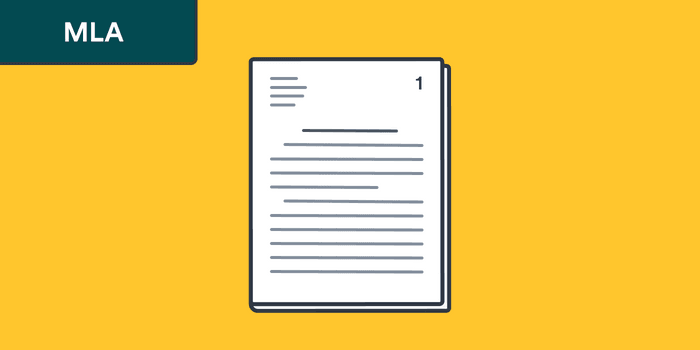
If you were instructed to include a cover or title page for your paper in MLA style 8th edition, these are the requirements you have to meet to have a proper MLA title page.
MLA cover page requirements
- 1 inch margins on all sides.
- Easily readable typeface (like Times New Roman), 11 or 12 points.
- Double-spacing throughout the paper.
- A header in the upper right-hand corner: give your last name, followed by a space with the page number. This should be included on all pages, one-half inch from the top.
- A header in the upper left-hand corner: author's name, instructor's name, the course, and the due date on separate lines and double-spaced.
- Right after, add the title on a new, double-spaced line, centered, in standard capitalization.
- Add a double space after the title and start with the first line of the text.
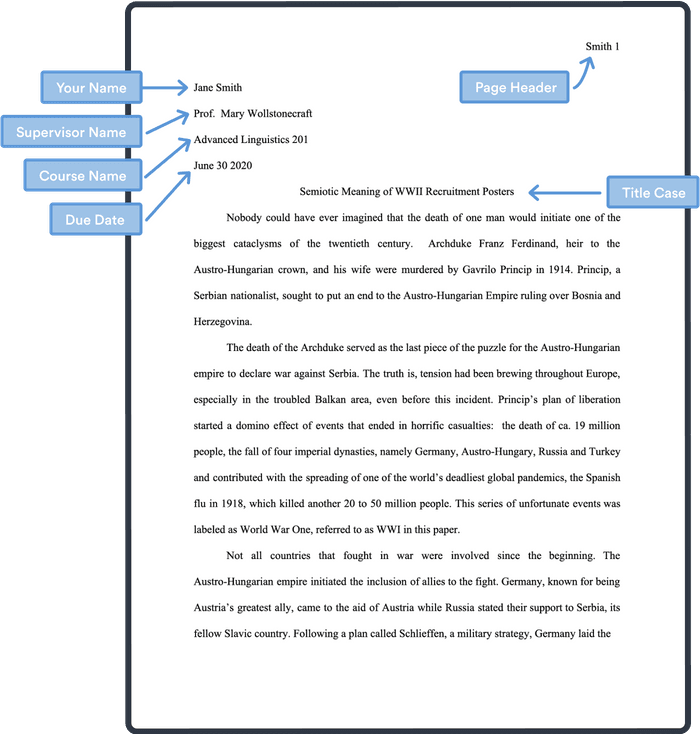
We created an MLA title page template (8th edition) for you to download:
Further reading
For more details not covered in this guide, take a look at the following sources:
📝 Sample papers in MLA Style
📑 MLA Style: Formatting a Research Paper
Frequently Asked Questions about MLA title page
Yes, according to MLA style, this is the only format to follow for any student or professional paper.
Yes, an MLA title page is very easy to format as it does not follow the classic format of a title page. You only have to add two headers in both upper corners of your paper's first page, the title, and right underneath you start writing. Piece of cake!
No. According to MLA style, the title should be written in the same font and format as the rest of the text. The title should only be placed centered.
Yes, a title page in MLA style should be numbered as page 1 of the paper.
If you learn better by watching than by reading, here is a YouTube tutorial that will help you create a title page in MLA style: MLA Essay Format (8th Edition) by The Nature of Writing.

Make your life easier with our productivity and writing resources.
For students and teachers.
MLA Format: A Complete Guide with Examples
#scribendiinc
Written by Scribendi
Your instructor has asked you to format your term paper using Modern Language Association (MLA) style. You feel confident enough to produce the paper, but you have never heard of MLA style. Don't panic—we've got you covered.
This article will explain MLA style citation, give examples of MLA formatting for specific aspects of references, provide an MLA format example for each category of source material, and share essay formatting tips that our editors have learned over the years.
You'll even find a free, downloadable MLA Works Cited example page for easy reference. So, if you have a general understanding of what MLA style is and are just looking for examples of MLA citations, we can help with that too!
Free MLA Cheat Sheet
What Is MLA Style?
MLA style is an accepted way to document source material for many types of humanities documents. Some would say it is simpler than other style guides, such as the APA Style Guide or the Chicago Manual of Style .
An MLA citation has two basic requirements:
Brief parenthetical citations in the text
An alphabetical list of the works cited that corresponds to the in-text citations and appears at the end of the paper
In simple terms, you refer to your source material in parentheses throughout the main text—then, at the end of your paper, you list all the sources to which you have referred, in alphabetical order.
Of course, there is so much more to MLA style and MLA formatting than just that. Indeed, the current version of the MLA Handbook for Writers of Research Papers (7th Edition) runs to 292 pages! But here are the essential style and formatting points.
MLA Format Citation Example
To start, let's look at a basic example of how to format a citation in MLA.
Last Name, First Name. "Title of Webpage/Chapter/Article." Website/Book Title/Journal Title , edition used, vol. X, no. Y, Publisher,
Day Month Year of Publication, URL/location/page number.
This is MLA format at its simplest.
Why Use MLA Format (or Any Other)?
The main reason for carefully citing source material is to avoid allegations of plagiarism, which—derived from the Latin word for "kidnapping"—refers to stealing someone else's work. The MLA Handbook explains plagiarism in detail. You should feel free to use another person's words, facts, and thoughts in your research paper, but the material you borrow must not be presented as if it were your own creation.
When you write your research paper, remember that you must document everything that you borrow—not only direct quotations and paraphrases but also information and ideas. Our MLA citation guide will walk you through how to properly cite your sources using MLA style.
Who Uses MLA Citation Format?
MLA-style citation is commonly used by writers and students who create content in the humanities.
You'll often see it used for the following subject areas:
Language and literature
Comparative literature
Literary criticism
Cultural studies
Foreign languages
Using MLA's citation guide in these fields of study gives readers an easier option for navigating through your paper. In addition to making you look credible by neatly organizing your sources, MLA citation lends consistency to your work. It provides readers with the opportunity to easily find sources in your paper that interest them.
How to Use MLA Format
The early stages of producing a paper involve copious amounts of reading, research, and note-taking. At this point, it's easy to get confused about who said what. The best way to avoid getting confused right from the start is to keep your ideas, your summary of others' ideas, and direct transcriptions of text clearly marked and separate. Throughout our guide, we'll provide examples of MLA citation to give you a hand.
Make notes on the following elements for ease of reference and proper MLA citation later on:
Author's name
Full title of each publication (from the title page, not the front cover)
City of publication (cite only the first city if there is more than one)
Date of publication
Volume and issue numbers, if available (for journals)
Page numbers you have referenced
Medium of publication or reception (print, web, radio, television, etc.)
Laying the groundwork during your research will make the citation process much easier later on.
MLA Citation Format
Because we know there are many ways to cite a reference in MLA, depending on what source you're using, we've compiled an extensive list of MLA citation examples below.
You'll find MLA citation examples for articles, books, images, interviews, journals, movies, and more to ensure you are citing your sources correctly.
We've done our best to be as thorough as possible. Review how to use in-text citations in MLA below or skip to the ones you need most!
How to Cite Two to Three Authors
If you're citing a book in MLA format with two or three authors, use the examples below to format your citation:
Bringham, Darrin E., and Sally Knope. Resting Heartbeat Science . 12th ed., Wiley, 2001.
Christopherson, Charles, Ronald Swanson, and Roger Koltz. Fog Pirates: On Board the USS Hammerhead . Putters, 2001.
Only the first author is listed by their last name followed by their first name. Any subsequent authors are written normally (first name then last name).
How to Cite More than Three Authors
When there are more than three authors to reference in MLA, format your citation using et al., as shown below:
Niderbacher, Leslie A., et al. Penne and the Jets: A Love Story . Partridge, 2003.
Note that only the first author is fully named, followed by et al.
Related: Learn more about How to Use Et Al. here.
How to Cite No Author
An MLA in-text citation with no author begins with the title . If your in-text citation has no author in MLA, you can also use the title in addition to the page number.
( Encyclopedia of Football 54)
How to Cite a Journal Article
Correct MLA article citation starts with finding good, credible articles. Try looking for peer-reviewed scholarly journal articles in free research databases such as CORE and ScienceOpen.
When searching for the best journals for your topic, try to steer clear of regular search engines like Google or Yahoo. Academic databases like JSTOR and Google Scholar are the best sources for scholarly, peer-reviewed articles .
MLA journal citation elements include the title of the work, author(s), and publication date. While this information is usually found on the first page of an article, its placement can vary. It may be at the top or bottom of the first page or, in the case of database articles, on the results page or the description page.
Related: Check out our list of 17 Research Databases for Free Articles .
MLA Citation for an Article
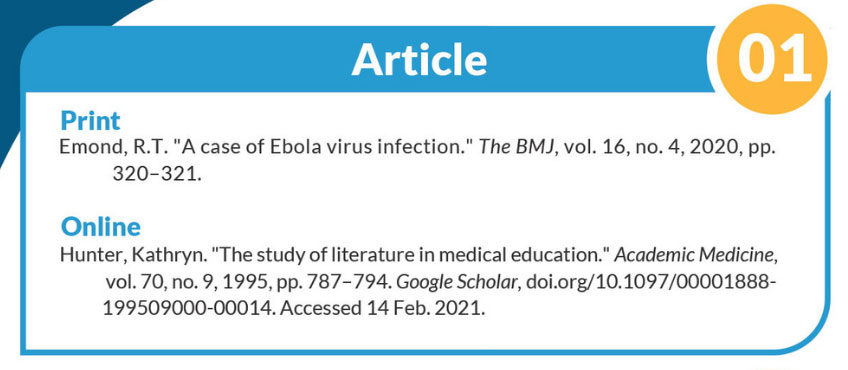
MLA Article Citation Examples
Lau, Frank. "Vitamin D Insufficiency is Prevalent in Severe COVID-19." Journal of Health , vol. 2, no. 5, Aug. 2020, pp. 34–27.
https://doi.org/10.1101/2020.04.24.20075838.
Kuehn, Bridget. "Hospitals Turn to Housing to Help Homeless Patients." JAMA , Feb. 2019, pp. 5–9.
https://doi.org/10.1001/jama.2018.21476.
MLA Website Article Citation Examples
Tomky, Naomi. "Explore the Oregon Coast—but don't touch the 'dragon toes.'" National Geographic , 23 Mar. 2022,
https://www.nationalgeographic.com/travel/article/explore-oregon-coast-but-dont-touch-dragon-toe-barnacles.
Gateley, Cheyne. "Netflix's Password Crackdown Will Be Tougher Than It Seems." Variety , 21 Mar. 2022,
https://variety.com/vip/netflixs-password-crackdown-will-be-tougher-than-it-seems-1235208619/.
Book Citation in MLA
If you're citing passages from a book using MLA, look at the title page of the book to find the information you need to cite the source. The title page can usually be found a couple of pages into the book. This is where you'll find the author(s), date, edition, title, editors (if any), place of publication, and publisher.
MLA Book Citation Examples
Schucman, Helen. A Course in Miracles. Edited by Robert Perry, The Circle of Atonement, Inc., 2017.
MLA Textbook Citation Examples
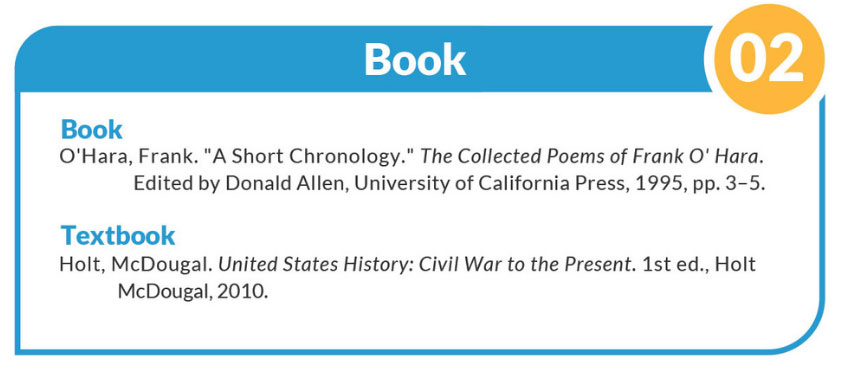
How to Cite an Image
Image citation in MLA requires you to first define what type of image you're sourcing. Is it an image you saw in person or an image from a website?
Asking yourself this question first will help you decide which format to use to cite your image. Let's look at a few examples below.
MLA Image Citation Examples
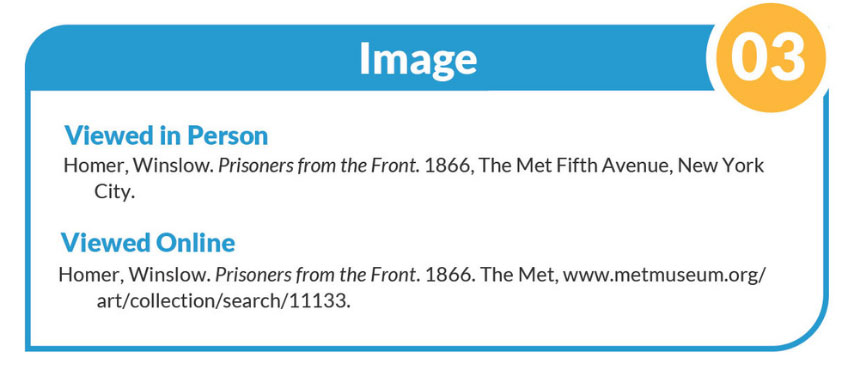
How to Cite an Image from a Website
To cite an image from a website in MLA, start with the image creator's last and first name, then add the image title, the website name , day, month, and year published, and the URL.
In the example below, there is no image title, so we're using a description of the image:
Yam, Marcus. Photograph of a man hurrying away from a building hit by Russian bombs. Los Angeles Times , 25 Mar. 2022,
www.latimes.com/world-nation/story/2022-03-25/ukraine-russia-war-biden-heads-to-poland .
Here is an example with an image title:
Clancy, Pat. "Foggy Sunrise." Flickr , 10 Mar. 2022,
https://www.flickr.com/photos/128721907@N02/51958337614/in/explore-2022-03-24/.
MLA Citation: Interview
When citing an interview in MLA, the information you need can vary depending on the type of interview.
For example, if you're citing an interview printed in a magazine, you can find relevant citation information in the title or subtitle of the interview page.
For online interviews, the relevant information can be found on the site where the interview was published. Typically, in the title or near the name of the person who published the interview, you'll find the names of the interviewer and interviewee, as well as the date the interview was published.
Here are a few elements you'll need if you're citing an interview in MLA:
Interviewee's first and last name
Interviewer's first and last name
Interview title
Periodical or journal title (if any)
Type of interview
Date the interview was conducted/published
URL of the interview (if online)
Page numbers of the interview (if in print)
In MLA, if you can't find the author of an interview you're trying to source, this information can be skipped. Instead, you can start your citation with the title of the interview in quotation marks. You can also skip the date of the interview if it is missing, but you should still include the access date if the interview is online.
If, for any reason, you also can't access the title of the interview, MLA allows you to replace the title with a short description. Let's look at a couple of examples below.
MLA Interview Citation Examples
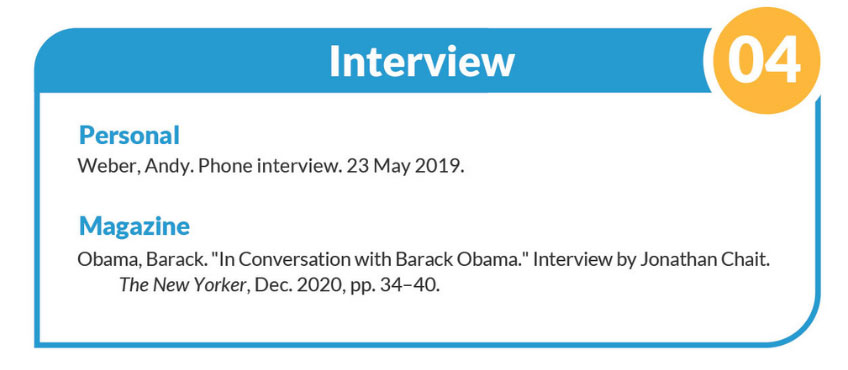
How to Cite a Lecture
When citing a lecture in MLA, start with the speaker's last and first names, followed by the lecture title in quotes, then the course or event name, the day, month, and year, the institution, the location, and the word "Lecture." Below is an example of how to cite a lecture in MLA.
MLA Lecture Citation Example
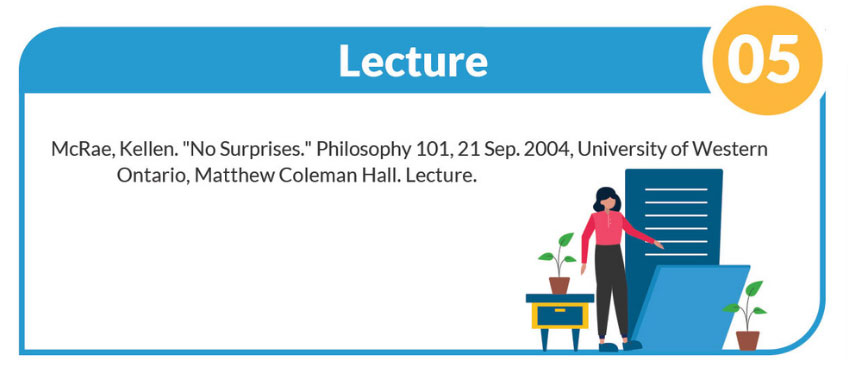
How to Cite a Movie in MLA
If you need to cite a movie in MLA style, you'll need the title of the film, the director, any relevant contributors, the company that produced/distributed the film, and the release year. Be sure to add the words "Directed by" before the director's name, as you'll see in the examples below.
MLA Movie Citation Examples
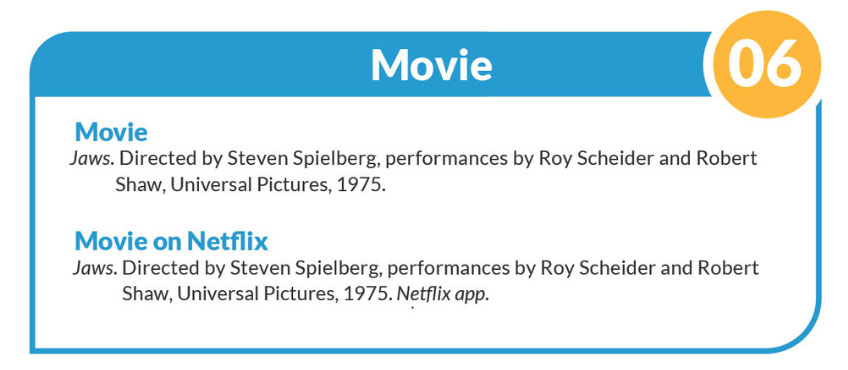
How to Cite a Poem
To cite a poem in MLA, begin with listing the author's last name and first, then the poem's title in quotes, followed by the title of the book the poem was found in, and the publisher, year, and page number(s).
MLA Poem Citation Examples
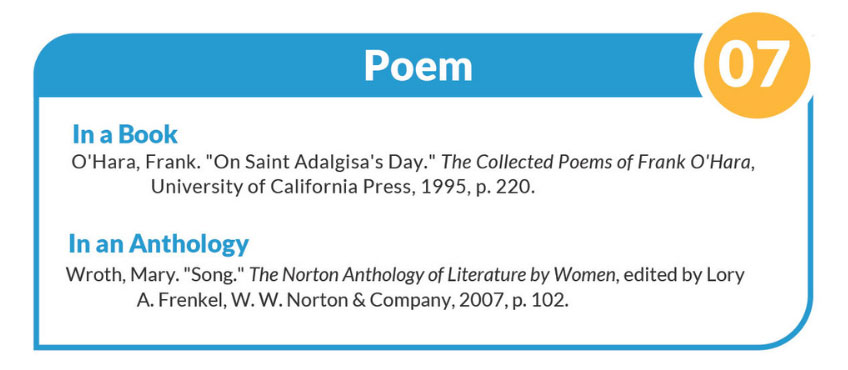
Quotes in MLA Format
When you're using a quote, you're taking the exact words from an original source, so you need to make sure you're citing that source correctly.
In MLA format, quotes should be cited in the main text and on the Works Cited page. Your in-text citation will need the author's last name and the page number where you found the quote , while the Works Cited page will include the full citation. We've included examples of both MLA quote citation formats below.
MLA Short Quote Citation Examples
In-text citation example:
It appears that creating "businesses that diminish the quality of life and well-being of our citizens" (Williamson 109) will only make things worse.
Works Cited example:
Williamson, Marianne. A Politics of Love . Harper One, 2019.
MLA Format for Long Quotes
If you have to cite quotes longer than four lines in your paper, you'll want to use a block quote. The MLA format is the same on the Works Cited page for long and short quotes, but block quotes look different in the main text.
Block quotes are placed in a separate paragraph, indented 1 inch from the left margin. When using a block quote in text, include the last name of the author and page number(s) in parentheses after the closing punctuation at the end of the quote.
Note that block quotes are not enclosed in quotation marks.
How to Cite a Song in MLA
When citing a song in MLA, pay close attention to the medium you used to access it. If you heard the song on a CD or on a streaming service like Spotify, you'll want to include this in your reference.
For in-text citations of songs, you'll include your citation at the end of your paraphrased portion with the last name of the performer and the specific time stamp of the song. Other elements needed for the citation on the Works Cited page include the album name, label, and release date.
MLA Song Citation Examples
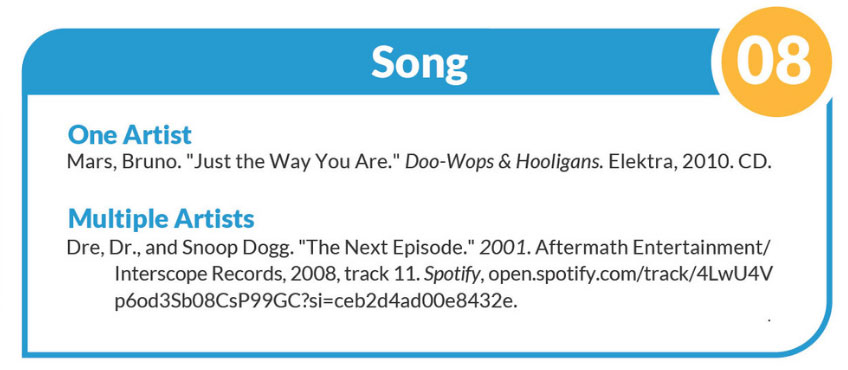
How to Cite a Video
An MLA citation for a YouTube video requires a few pieces of information, including the video creator's name, the title of the video, the website hosting the video, the name of the channel or uploader, the day, month , and year the video was published, and its URL.
Regardless of the platform from which you cite a video, MLA requires the same standard information, including the creator of the video, the title, where it was found, who uploaded it, the day, month, and year it was uploaded, and the URL.
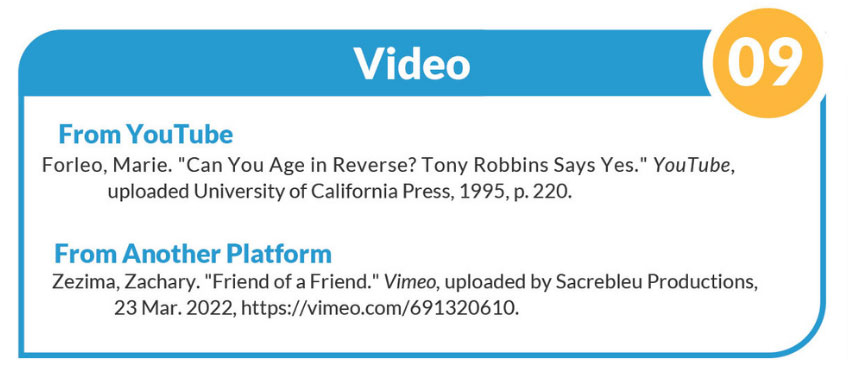
How to Cite a Website in MLA
The MLA format for websites requires a few core elements, including the author, title of the source and container, relevant contributors, version, publisher, publication date in day-month-year format, and DOI or URL .
Some of this information can be omitted if it isn't available. See the examples below.
MLA Format for Websites
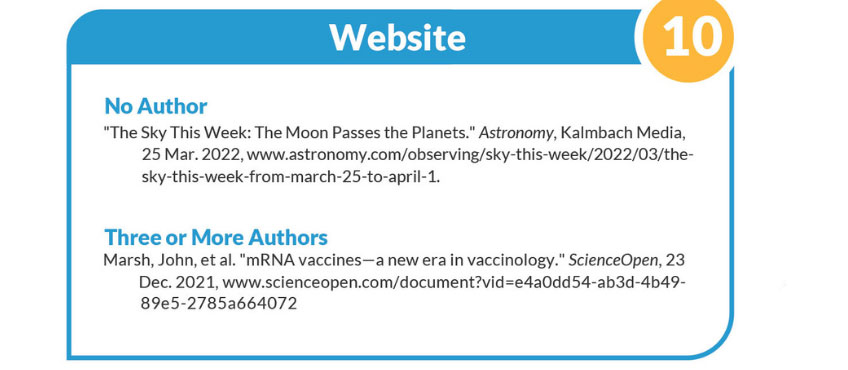
More about MLA Style and Format
Mla heading format.
When you're writing a paper in MLA format, headings go on the first page . Your heading should include the following information:
Instructor's name
Course name or number
Submission date
Your MLA heading goes in the upper left corner of your paper, double-spaced. Try not to confuse an MLA heading with an MLA header, which is in the upper right corner of every page of your paper and includes your last name and the page number.
MLA Format Heading Examples
Here are two example headings in MLA format for reference. Keep in mind that these should be double-spaced in your paper.
Cody Anderson
Professor Lockhart
Astronomy 103
23 March 2022
Raquel Smith
Professor Snape
Humanities 605
25 February 2021

MLA In-Text Citation
In the next few sections, we'll look at MLA formatting for sources cited within the main text of your paper, also called in-text citations. In-text citations give your reader a clue about where to find the source you referenced in the Works Cited section at the end of your paper.
MLA format for books requires that you briefly acknowledge your sources in the main body of the text by using the author's name and the page number in parentheses.
Note the following example:
(Clinton 440).
The reader knows to consult page 440 of Clinton's book.
Larger Works
If you refer to the title of a large published work in your paper, such as a novel or movie, it should appear as follows:
John Clinton's A Study of Life.
Please note the use of capital letters and italics.
Smaller Works
Titles of smaller works, such as poems, short stories, chapters, and articles, should be written in the text as follows:
Raymond Carver's "Cathedral."
Please note that smaller works are put in quotation marks and are not italicized.
MLA Works Cited
To obtain further information, the reader can refer to the alphabetical references section, called the Works Cited page, at the end of the paper. There, the reader can find the full details of each cited publication.
Note the following MLA Works Cited example:
Clinton, John. A Study of Life . London: Hodder, 1998. Print.
Our John Clinton example is MLA style referencing in its simplest form: one author and one book. MLA citation for multiple authors of a single book and MLA citation for multiple books by a single author tend to complicate matters. However, if you have the basics right and have made good notes for all your source material, these problems are manageable.
Multiple Books by One Author
When citing two or more books by one author in your Works Cited section, MLA requires the author's name in the first entry only. In the next entry, replace the author's name with an em dash (—), a period, and the second book title. The em dash takes the place of the author's name. In terms of the order of the books by one author on your Works Cited page, alphabetize the list by title.
Brunson, Russell. DotCom Secrets . Morgan James Publishing, 2015.
—. Traffic Secrets . Hay House, Inc., 2020.
MLA Format with Multiple Authors
When citing three or more authors in MLA, you'll want to use "et al.," which means "and others."
Levine, Robert S., et al. The Norton Anthology of American Literature . 9th ed., W.W. Norton & Company, 2022.
Missing Items
If you're trying to cite a source in MLA with missing information, you have a few options available to you depending on what information is missing.
If you're missing the author of a source, use the title of the work in its place for both in-text citations and citations in the Works Cited in MLA format. If your title is also missing, use the source instead.
If your source has no page numbers, you can omit these in your citations and use paragraph or line numbers if they are available.
If the date of the publication is missing, you don't have to include it. But if it's a resource you accessed online, include the access date at the end of the citation—for example, "Accessed 14 Sep. 2021."
You can also omit the publisher if this information is missing.
MLA Format Works Cited Page Tips
When formatting your Works Cited page in MLA format, be sure to pay close attention to all the guidelines. MLA requires all lines to be double-spaced with a hanging indent. A hanging indent is when the first line of your reference starts at the beginning of the line while the next lines are indented by an inch and a half from the left.
Free Download
To keep all of these MLA examples in one sheet for easy reference, we've compiled a free download. This way, you can review MLA citation examples anytime you need them, either for your Works Cited page or in-text citations, for multiple types of work.
Once downloaded, you'll have all of the MLA citation examples you need in your back pocket. This guide will give you examples of MLA citations for the following types of sources:
Books (with one author, multiple authors, or no author)
Download our free MLA downloadable here.
Download Now
Writing a paper in mla format.
When writing a paper in MLA format, you'll need to cover your bases when it comes to citing your sources. Not only do your sources need to be correct to account for wherever you're pulling information from, but they also need to follow MLA paper formatting basics .
So far, we've covered how to cite sources in your Works Cited list and in-text citations. Now, let's talk about how to use footnotes in an MLA paper with a couple of examples.
As a general rule, footnotes should be used sparingly in MLA. However, when they are used, there are two types: bibliographical footnotes and content footnotes.
Bibliographical footnotes allow you to add more relevant sources. Content footnotes allow you to add commentary or explanations about your topic. We'll look at examples of both of these below.
MLA Footnote Examples
Bibliographical footnote:
1 See Clinton, John. A Study of Life . Hodder, 1998. Additional references are for this edition and appear within the text.
Content footnote:
1 In a lecture from 2013, Peters mentions his love of science and how science will shape our future.
MLA Title Page Format
The MLA format cover page is not an entirely separate page. It begins with a 1-inch margin, flush left with your name, your instructor's name, the course name or number, and the date typed on separate, double-spaced lines.
The title of your research paper should then be centered on the MLA format title page. There is no need for it to be presented in bold, italics, or capital letters.
MLA Parenthetical Citation
When citing a source in your text in MLA, use a parenthetical citation.
Parenthetical citations in MLA should include the author's last name and the page number where you found the information.
For example: (Lars 86).
MLA Page Number Format
In MLA format, page numbers appear in the top right-hand corner with a 0.5-inch margin from the top and a flush right margin. It is good practice to include your last name before the page number in case pages go astray. Do not use the abbreviation p. before the page number or add any other mark or symbol. You may not need to include a page number on the front page—check with your instructor.
Sometimes, it is appropriate to draw attention to particular words in your paper, but using italics for emphasis ("He really ate a lot ") is inappropriate in research writing and inconsistent with MLA style. Generally, in MLA format, italics should be reserved for titles of longer works (e.g., books, films), non-English words, and words and letters referred to as words and letters.
MLA Format Essay Tips
Your instructor may issue particular instructions if you are to use MLA citation in an essay—if so, follow them. Otherwise, the following MLA essay formatting tips will help you set out your research paper in MLA style.
The MLA Style Guide recommends using a clear typeface (Arial or Times New Roman) in a readable size (at least 11 point).
Justification
Justify the text to the left margin, leaving the right margin ragged. Leave 1-inch margins on the top, bottom, left, and right of the page.
Indent the first word in each paragraph by 0.5 inches. Indent set-off block quotations by 1 inch.
Use double-spacing throughout. In accordance with the MLA guide, use single spaces after periods, commas , exclamation marks, etc.
Good grammar, punctuation , and spelling are essential parts of your research paper—not just when using MLA style citation. There is no room for typos at this level.
Our advice is to check and check again, and don't just rely on your word processor's spell-checker. Get a second pair of eyes to look over your paper. T ry our essay editors to ensure that the MLA formatting is consistent throughout your paper and there are no grammatical errors.
Related: Avoid These Common Mistakes in Academic and Scientific Writing
The importance of citing your references in your essay cannot be understated. Any time you include a piece of information in your essay that you didn't write yourself, MLA requires two forms of citation: one in the main text and one at the end of your paper in the Works Cited section.
MLA Format Essay Example
To see how all these formatting elements come together to make an MLA paper, see the example below.
https://p113.p2.n0.cdn.getcloudapp.com/items/v1ugxp7E/9e3b21d9-758c-4e27-b6cb-caa1059c0547.jpeg?v=559e925043cbfee9fe816e0568ab3d3b
Electronic Sources and MLA Formatting
In this computerized age, electronic publications are widely used as source materials for essays. However, electronic texts are prone to frequent and rapid change—one minute you see them online, and the next they are gone. Therefore, it is important to provide more information when references to electronic works are made.
When accessing electronic information, note the following elements:
Name of the author, editor, etc.
Title of the work
Title of the website (if distinct from the title of the work)
Version/edition used, if applicable
Publisher or sponsor of the site (if not available, use n.p.)
Date of publication (day, month, and year, if available; if no date is available, use n.d.)
Medium of publication (web)
Date of access (day, month, and year)
Note the following example of MLA citation:
Smith, George. "Trees of the Southern Hemisphere." The International Leaf. Barker University, 2008. Web. 6 Feb. 2009.
Please note that the MLA formatting and style guide no longer recommends including the URL of a document. Nevertheless, the URL can be included if it is required by your instructor or if your readers will have difficulty locating the source without it.
MLA Format Letter
Below, you'll find examples of how to apply the MLA letter format. Much of the formatting will be similar to that of MLA-style papers, including using double-spaced lines in your text.
MLA Letter Heading Format
Start your MLA-formatted letter with your two-line mailing address in the upper left-hand corner, an inch from the top of the page. Skip to the next line and add the date in day-month-year format.
On the next line, include the addressee's information, starting with the recipient's title, such as Mr., Ms., or Dr. You can also include their address and contact information.
On yet another line, include your salutation—for example, "Dear Ms. Smith"—followed by a colon. If you don't have a name for the person you're writing to, use the person's title—for example, "Dear Director of Operations."
When writing a letter in MLA format, be sure to use double-spacing throughout as you would in an MLA paper.
Chicago vs. MLA vs. APA Citation
The formatting of citations varies among style guides like Chicago, MLA, and APA. While each style guide has its own way of formatting sources and cover pages, one of the biggest differences is in how they format in-text citations. Let's look at how they differ.
MLA stands for the Modern Language Association and is a style used for papers in the humanities. In-text citations in MLA use the author's last name and page number in parentheses: (Smith 15).
APA stands for the American Psychological Association and is a style used for scientific papers. In-text citations in APA style include a bit more information than those in MLA style. For example, APA uses the author's last name, year of publication, and page number: (Smith, 2021, p. 15).
Chicago style is used mainly for manuscripts by writers, designers, and publishers. In-text citations in this style include the last name of the source, the publication year, and the page number in parentheses, with slightly different formatting than APA: (Smith 2021, 15).
Frequently Asked Questions
How do i cite a website in mla.
To cite a website in MLA, start with the author's last name and first name separated by a comma and punctuated with a period. Next, include the title of the article or page in headline case and in quotes with a period, followed by the title of the website in italics. After that, add a comma, the name of the publisher, the publication date in day-month-year format, and the URL.
Shields, Ronan. "'The Threat is Hollow': True Transparency is Some Way Off for Scaled Advertisers." Digiday , Digiday Media, 25
Mar. 2022, https://digiday.com/marketing/the-threat-is-hollow-true-transparency-is-some-way-off-for-scaled-advertisers/.
Basu, Tyler. "How to Build a Personal Brand (Complete Guide)." Thinkific , Thinkific, 7 Sep. 2021,
https://www.thinkific.com/blog/personal-branding-guide/.
For an MLA website in-text citation, simply put the last name of the author in parentheses: (Shields).
How Do I Cite a Journal Article in MLA?
The MLA citation for a journal article begins with the author's last name and first name separated by a comma. Next, include the title of the article in quotes, punctuated by a period, then the journal title in title case and italics, and then a comma before the volume or issue number. This is followed by the date of publication, the page range, and the DOI or URL (without https://). Finally, add the access date if no publication date is listed.
How Do I Write In-Text Citations in MLA?
In-text citations allow readers to identify which of the items on your Works Cited page you're referencing. MLA requires the source's last name to be set in parentheses, followed by the page number where you found the information. Below are a few examples of how to use in-text citations in MLA format.
(Smith and Jones 53)
(Smith et al. 33)
(Smith 56–58)
(Smith 56–58, 73)
How Do I Cite a YouTube Video in MLA?
For MLA YouTube citation, start with the video creator's last name and first name, separated by a comma and punctuated by a period. Next, include the title of the video in quotes, also punctuated by a period (inside the quotation marks).
Add the website hosting the video in italics (in this case, YouTube), the name of the channel or uploader, and the day, month, and year the video was published. Include the URL at the end of the MLA video citation.
Forleo, Marie. "Can You Age in Reverse? Tony Robbins Says Yes." YouTube , uploaded by Marie Forleo, 14 Feb. 2022,
https://www.youtube.com/watch?v=YAb5z7NbMYk.
Snipes, Doc. "15 Tips to Stop Ruminating and Get Out of Your Head." YouTube , uploaded by Doc Snipes, 23 Mar. 2022,
https://www.youtube.com/watch?v=yMZpMtM7TkI.
How Do I Use MLA Format for Headings?
Put your MLA heading in the upper left-hand corner of the first page of your paper , double-spaced. It should have your name, your instructor's name, the course name or number, and the date. Here are two examples of how to format your headings in MLA:
How Do I Cite a Movie in MLA Format?
To cite a movie in MLA style, start with the title of the film in italics, then the name of the director, followed by any relevant contributors. Next, include the company that produced or distributed the film and the release year.
Jaws . Directed by Steven Spielberg, performances by Roy Scheider and Robert Shaw, Universal Pictures, 1975.
To cite a movie from a streaming service such as Netflix, use the following format:
Jaws . Directed by Steven Spielberg, performances by Roy Scheider and Robert Shaw, Universal Pictures, 1975. Netflix app.
How Do I Format My Paper Using MLA?
To recap the most important MLA formatting guidelines, be sure to use 1-inch margins all around your paper, set the font to 12-point Times New Roman (or another easy-to-read font), and double-space the lines in your text. Make sure each word at the start of your paragraphs is indented half an inch from the left margin, and do the same for any block quotations.
You must cite all your sources in MLA, both in the text and on the Works Cited page found at the end of your paper. Use the examples and guidelines above to make sure you're formatting your paper and citations according to MLA guidelines.
How Do I Cite a Person in MLA?
If you're citing an interview, use the last and first name of the person interviewed at the start of your MLA Works Cited citation. Then, add the interview title, periodical title, type of interview, date, and URL of the interview (if online).
If the person you're referencing was interviewed in print, include the page numbers.
For an in-text citation of an interview, use the last name of the person being interviewed—for example: (Smith).
Download our free MLA format PDF for more examples of how to cite a person in MLA for an interview, either one you've conducted yourself or one you found elsewhere.
About the Author

Scribendi's in-house editors work with writers from all over the globe to perfect their writing. They know that no piece of writing is complete without a professional edit, and they love to see a good piece of writing transformed into a great one. Scribendi's in-house editors are unrivaled in both experience and education, having collectively edited millions of words and obtained nearly 20 degrees. They love consuming caffeinated beverages, reading books of various genres, and relaxing in quiet, dimly lit spaces.
Have You Read?
"The Complete Beginner's Guide to Academic Writing"
Related Posts

Examples of MLA Citations

MLA Citations: A How-To Guide

MLA Formatting and MLA Style: An Introduction
Upload your file(s) so we can calculate your word count, or enter your word count manually.
We will also recommend a service based on the file(s) you upload.
| File | Word Count | Include in Price? |
|---|
English is not my first language. I need English editing and proofreading so that I sound like a native speaker.
I need to have my journal article, dissertation, or term paper edited and proofread, or I need help with an admissions essay or proposal.
I have a novel, manuscript, play, or ebook. I need editing, copy editing, proofreading, a critique of my work, or a query package.
I need editing and proofreading for my white papers, reports, manuals, press releases, marketing materials, and other business documents.
I need to have my essay, project, assignment, or term paper edited and proofread.
I want to sound professional and to get hired. I have a resume, letter, email, or personal document that I need to have edited and proofread.
Prices include your personal % discount.
Prices include % sales tax ( ).

Purdue Online Writing Lab Purdue OWL® College of Liberal Arts
MLA Formatting and Style Guide

Welcome to the Purdue OWL
This page is brought to you by the OWL at Purdue University. When printing this page, you must include the entire legal notice.
Copyright ©1995-2018 by The Writing Lab & The OWL at Purdue and Purdue University. All rights reserved. This material may not be published, reproduced, broadcast, rewritten, or redistributed without permission. Use of this site constitutes acceptance of our terms and conditions of fair use.
The following overview should help you better understand how to cite sources using MLA 9 th edition, including how to format the Works Cited page and in-text citations.
Please use the example at the bottom of this page to cite the Purdue OWL in MLA. See also our MLA vidcast series on the Purdue OWL YouTube Channel .
Creating a Works Cited list using the ninth edition
MLA is a style of documentation that may be applied to many different types of writing. Since texts have become increasingly digital, and the same document may often be found in several different sources, following a set of rigid rules no longer suffices.
Thus, the current system is based on a few guiding principles, rather than an extensive list of specific rules. While the handbook still describes how to cite sources, it is organized according to the process of documentation, rather than by the sources themselves. This gives writers a flexible method that is near-universally applicable.
Once you are familiar with the method, you can use it to document any type of source, for any type of paper, in any field.
Here is an overview of the process:
When deciding how to cite your source, start by consulting the list of core elements. These are the general pieces of information that MLA suggests including in each Works Cited entry. In your citation, the elements should be listed in the following order:
- Title of source.
- Title of container,
- Other contributors,
- Publication date,
Each element should be followed by the corresponding punctuation mark shown above. Earlier editions of the handbook included the place of publication and required different punctuation (such as journal editions in parentheses and colons after issue numbers) depending on the type of source. In the current version, punctuation is simpler (only commas and periods separate the elements), and information about the source is kept to the basics.
Begin the entry with the author’s last name, followed by a comma and the rest of the name, as presented in the work. End this element with a period.
Bhabha, Homi K. The Location of Culture. Routledge, 1994.
Title of source
The title of the source should follow the author’s name. Depending upon the type of source, it should be listed in italics or quotation marks.
A book should be in italics:
Henley, Patricia. The Hummingbird House . MacMurray, 1999.
An individual webpage should be in quotation marks. The name of the parent website, which MLA treats as a "container," should follow in italics:
Lundman, Susan. "How to Make Vegetarian Chili." eHow, www.ehow.com/how_10727_make-vegetarian-chili.html.*
A periodical (journal, magazine, newspaper) article should be in quotation marks:
Bagchi, Alaknanda. "Conflicting Nationalisms: The Voice of the Subaltern in Mahasweta Devi's Bashai Tudu." Tulsa Studies in Women's Literature , vol. 15, no. 1, 1996, pp. 41-50.
A song or piece of music on an album should be in quotation marks. The name of the album should then follow in italics:
Beyoncé. "Pray You Catch Me." Lemonade, Parkwood Entertainment, 2016, www.beyonce.com/album/lemonade-visual-album/.
*The MLA handbook recommends including URLs when citing online sources. For more information, see the “Optional Elements” section below.
Title of container
The eighth edition of the MLA handbook introduced what are referred to as "containers," which are the larger wholes in which the source is located. For example, if you want to cite a poem that is listed in a collection of poems, the individual poem is the source, while the larger collection is the container. The title of the container is usually italicized and followed by a comma, since the information that follows next describes the container.
Kincaid, Jamaica. "Girl." The Vintage Book of Contemporary American Short Stories, edited by Tobias Wolff, Vintage, 1994, pp. 306-07.
The container may also be a television series, which is made up of episodes.
“94 Meetings.” Parks and Recreation, created by Greg Daniels and Michael Schur, performance by Amy Poehler, season 2, episode 21, Deedle-Dee Productions and Universal Media Studios, 2010.
The container may also be a website, which contains articles, postings, and other works.
Wise, DeWanda. “Why TV Shows Make Me Feel Less Alone.” NAMI, 31 May 2019, www.nami.org/Blogs/NAMI-Blog/May-2019/How-TV-Shows-Make-Me-Feel-Less-Alone . Accessed 3 June 2019.
In some cases, a container might be within a larger container. You might have read a book of short stories on Google Books , or watched a television series on Netflix . You might have found the electronic version of a journal on JSTOR. It is important to cite these containers within containers so that your readers can find the exact source that you used.
“94 Meetings.” Parks and Recreation , season 2, episode 21, NBC , 29 Apr. 2010. Netflix, www.netflix.com/watch/70152031?trackId=200256157&tctx=0%2C20%2C0974d361-27cd-44de-9c2a-2d9d868b9f64-12120962.
Langhamer, Claire. “Love and Courtship in Mid-Twentieth-Century England.” Historical Journal , vol. 50, no. 1, 2007, pp. 173-96. ProQuest, doi:10.1017/S0018246X06005966. Accessed 27 May 2009.
Other contributors
In addition to the author, there may be other contributors to the source who should be credited, such as editors, illustrators, translators, etc. If their contributions are relevant to your research, or necessary to identify the source, include their names in your documentation.
Foucault, Michel. Madness and Civilization: A History of Insanity in the Age of Reason. Translated by Richard Howard , Vintage-Random House, 1988.
Woolf, Virginia. Jacob’s Room . Annotated and with an introduction by Vara Neverow, Harcourt, Inc., 2008.
If a source is listed as an edition or version of a work, include it in your citation.
The Bible . Authorized King James Version, Oxford UP, 1998.
Crowley, Sharon, and Debra Hawhee. Ancient Rhetorics for Contemporary Students. 3rd ed., Pearson, 2004.
If a source is part of a numbered sequence, such as a multi-volume book or journal with both volume and issue numbers, those numbers must be listed in your citation.
Dolby, Nadine. “Research in Youth Culture and Policy: Current Conditions and Future Directions.” Social Work and Society: The International Online-Only Journal, vol. 6, no. 2, 2008, www.socwork.net/sws/article/view/60/362. Accessed 20 May 2009.
Quintilian. Institutio Oratoria. Translated by H. E. Butler, vol. 2, Loeb-Harvard UP, 1980.
The publisher produces or distributes the source to the public. If there is more than one publisher, and they are all are relevant to your research, list them in your citation, separated by a forward slash (/).
Klee, Paul. Twittering Machine. 1922. Museum of Modern Art, New York. The Artchive, www.artchive.com/artchive/K/klee/twittering_machine.jpg.html. Accessed May 2006.
Women's Health: Problems of the Digestive System . American College of Obstetricians and Gynecologists, 2006.
Daniels, Greg and Michael Schur, creators. Parks and Recreation . Deedle-Dee Productions and Universal Media Studios, 2015.
Note : The publisher’s name need not be included in the following sources: periodicals, works published by their author or editor, websites whose titles are the same name as their publisher, websites that make works available but do not actually publish them (such as YouTube , WordPress , or JSTOR ).
Publication date
The same source may have been published on more than one date, such as an online version of an original source. For example, a television series might have aired on a broadcast network on one date, but released on Netflix on a different date. When the source has more than one date, it is sufficient to use the date that is most relevant to your writing. If you’re unsure about which date to use, go with the date of the source’s original publication.
In the following example, Mutant Enemy is the primary production company, and “Hush” was released in 1999. Below is a general citation for this television episode:
“Hush.” Buffy the Vampire Slayer , created by Joss Whedon, performance by Sarah Michelle Gellar, season 4, Mutant Enemy, 1999 .
However, if you are discussing, for example, the historical context in which the episode originally aired, you should cite the full date. Because you are specifying the date of airing, you would then use WB Television Network (rather than Mutant Enemy), because it was the network (rather than the production company) that aired the episode on the date you’re citing.
“Hush.” Buffy the Vampire Slayer, created by Joss Whedon, performance by Sarah Michelle Gellar, season 4, episode 10, WB Television Network, 14 Dec. 1999 .
You should be as specific as possible in identifying a work’s location.
An essay in a book or an article in a journal should include page numbers.
Adiche, Chimamanda Ngozi. “On Monday of Last Week.” The Thing around Your Neck, Alfred A. Knopf, 2009, pp. 74-94 .
The location of an online work should include a URL. Remove any "http://" or "https://" tag from the beginning of the URL.
Wheelis, Mark. "Investigating Disease Outbreaks Under a Protocol to the Biological and Toxin Weapons Convention." Emerging Infectious Diseases , vol. 6, no. 6, 2000, pp. 595-600, wwwnc.cdc.gov/eid/article/6/6/00-0607_article. Accessed 8 Feb. 2009.
When citing a physical object that you experienced firsthand, identify the place of location.
Matisse, Henri. The Swimming Pool. 1952, Museum of Modern Art, New York .
Optional elements
The ninth edition is designed to be as streamlined as possible. The author should include any information that helps readers easily identify the source, without including unnecessary information that may be distracting. The following is a list of optional elements that can be included in a documented source at the writer’s discretion.
Date of original publication:
If a source has been published on more than one date, the writer may want to include both dates if it will provide the reader with necessary or helpful information.
Erdrich, Louise. Love Medicine. 1984. Perennial-Harper, 1993.
City of publication:
The seventh edition handbook required the city in which a publisher is located, but the eighth edition states that this is only necessary in particular instances, such as in a work published before 1900. Since pre-1900 works were usually associated with the city in which they were published, your documentation may substitute the city name for the publisher’s name.
Thoreau, Henry David. Excursions . Boston, 1863.
Date of access:
When you cite an online source, the MLA Handbook recommends including a date of access on which you accessed the material, since an online work may change or move at any time.
Bernstein, Mark. "10 Tips on Writing the Living Web." A List Apart: For People Who Make Websites, 16 Aug. 2002, alistapart.com/article/writeliving. Accessed 4 May 2009.
As mentioned above, while the MLA handbook recommends including URLs when you cite online sources, you should always check with your instructor or editor and include URLs at their discretion.
A DOI, or digital object identifier, is a series of digits and letters that leads to the location of an online source. Articles in journals are often assigned DOIs to ensure that the source is locatable, even if the URL changes. If your source is listed with a DOI, use that instead of a URL.
Alonso, Alvaro, and Julio A. Camargo. "Toxicity of Nitrite to Three Species of Freshwater Invertebrates." Environmental Toxicology , vol. 21, no. 1, 3 Feb. 2006, pp. 90-94. Wiley Online Library, doi: 10.1002/tox.20155.
Creating in-text citations using the previous (eighth) edition
Although the MLA handbook is currently in its ninth edition, some information about citing in the text using the older (eighth) edition is being retained. The in-text citation is a brief reference within your text that indicates the source you consulted. It should properly attribute any ideas, paraphrases, or direct quotations to your source, and should direct readers to the entry in the Works Cited list. For the most part, an in-text citation is the author’s name and the page number (or just the page number, if the author is named in the sentence) in parentheses :
When creating in-text citations for media that has a runtime, such as a movie or podcast, include the range of hours, minutes and seconds you plan to reference. For example: (00:02:15-00:02:35).
Again, your goal is to attribute your source and provide a reference without interrupting your text. Your readers should be able to follow the flow of your argument without becoming distracted by extra information.
How to Cite the Purdue OWL in MLA
Entire Website
The Purdue OWL . Purdue U Writing Lab, 2019.
Individual Resources
Contributors' names. "Title of Resource." The Purdue OWL , Purdue U Writing Lab, Last edited date.
The new OWL no longer lists most pages' authors or publication dates. Thus, in most cases, citations will begin with the title of the resource, rather than the developer's name.
"MLA Formatting and Style Guide." The Purdue OWL, Purdue U Writing Lab. Accessed 18 Jun. 2018.
- PRO Courses Guides New Tech Help Pro Expert Videos About wikiHow Pro Upgrade Sign In
- EDIT Edit this Article
- EXPLORE Tech Help Pro About Us Random Article Quizzes Request a New Article Community Dashboard This Or That Game Happiness Hub Popular Categories Arts and Entertainment Artwork Books Movies Computers and Electronics Computers Phone Skills Technology Hacks Health Men's Health Mental Health Women's Health Relationships Dating Love Relationship Issues Hobbies and Crafts Crafts Drawing Games Education & Communication Communication Skills Personal Development Studying Personal Care and Style Fashion Hair Care Personal Hygiene Youth Personal Care School Stuff Dating All Categories Arts and Entertainment Finance and Business Home and Garden Relationship Quizzes Cars & Other Vehicles Food and Entertaining Personal Care and Style Sports and Fitness Computers and Electronics Health Pets and Animals Travel Education & Communication Hobbies and Crafts Philosophy and Religion Work World Family Life Holidays and Traditions Relationships Youth
- Browse Articles
- Learn Something New
- Quizzes Hot
- Happiness Hub
- This Or That Game
- Train Your Brain
- Explore More
- Support wikiHow
- About wikiHow
- Log in / Sign up
- Education and Communications
- Editing and Style
How to Do a Title Page in MLA Format
Last Updated: September 22, 2020 Fact Checked
This article was co-authored by Michelle Golden, PhD . Michelle Golden is an English teacher in Athens, Georgia. She received her MA in Language Arts Teacher Education in 2008 and received her PhD in English from Georgia State University in 2015. This article has been fact-checked, ensuring the accuracy of any cited facts and confirming the authority of its sources. This article has been viewed 1,281,961 times.
Many papers are written using MLA style. MLA style normally does not require a cover page because all of the important information is worked into the first page. However, some instructors do prefer a separate title page. In this case, use the following standards.
Title Page Help

Creating a Title Page

- Do not punctuate your title. It does not need to have quotation marks around it, it should not be underlined, and it should not be in italics. If, however, there is a quotation or a reference to a longer work in your title, that should be punctuated accordingly.
- For example, "To Be or Not to Be:" An Analysis of Hamlet's Soliloquy contains a quote, while An Analysis of Inaction in Shakespeare's Hamlet contains the title of the play, which should be italicized.

Community Q&A
- Use a standard 12 point font for all writing. Thanks Helpful 0 Not Helpful 0
- Use a standard 1 inch (2.5 cm) margin. Thanks Helpful 0 Not Helpful 0
- Use a standard font with a serif, such as Times New Roman or Garamond. Thanks Helpful 0 Not Helpful 0

- All information is written in the same size and font; there is no bold, italics or underlining. Thanks Helpful 22 Not Helpful 5
You Might Also Like

- http://homeworktips.about.com/od/mlastyle/ig/Sample-MLA-Pages/titlepage.htm
About This Article

To do a title page in MLA format, start by writing the title of your paper one-third of the way down the page, using normal title capitalization standards and not underlining or italicizing the title. Then, skip 2-3 lines and write your first and last name. Next, skip 2-3 more lines and write the name of the course or class you're writing the paper for. One the next line, write the instructor's name. Finally, on the next line, write the date with the day first, then the month and year. To learn how to punctuate the title on your MLA title page, keep reading! Did this summary help you? Yes No
- Send fan mail to authors
Reader Success Stories
Daniela Casas
Oct 13, 2016
Did this article help you?
Oct 24, 2016
Serenity Nichols
Jan 31, 2017

Featured Articles

Trending Articles

Watch Articles

- Terms of Use
- Privacy Policy
- Do Not Sell or Share My Info
- Not Selling Info
wikiHow Tech Help Pro:
Level up your tech skills and stay ahead of the curve
Generate accurate MLA citations for free
- Knowledge Base
- MLA format for academic papers and essays
MLA Format | Complete Guidelines & Free Template
Published on December 11, 2019 by Raimo Streefkerk . Revised on May 6, 2024 by Jack Caulfield.
The MLA Handbook provides guidelines for creating MLA citations and formatting academic papers. This includes advice on structuring parenthetical citations, the Works Cited page, and tables and figures. This quick guide will help you set up your MLA format paper in no time.
Cite your MLA source
Start by applying these MLA format guidelines to your document:
- Use an easily readable font like 12 pt Times New Roman
- Set 1 inch page margins
- Use double line spacing
- Include a ½” indent for new paragraphs
- Include a four-line MLA heading on the first page
- Center the paper’s title
- Use title case capitalization for headings
- Cite your sources with MLA in-text citations
- List all sources cited on a Works Cited page at the end
Alternatively, you can automatically apply the formatting with our MLA docx or Google Docs template.
Table of contents
How to set up mla format in google docs, header and title, running head, works cited page, creating mla style citations, headings and subheadings, tables and figures, frequently asked questions about mla format.
The header in MLA format is left-aligned on the first page of your paper. It includes
- Your full name
- Your instructor’s or supervisor’s name
- The course name or number
- The due date of the assignment
After the MLA header, press ENTER once and type your paper title. Center the title and don’t forget to apply title-case capitalization. Read our article on writing strong titles that are informative, striking and appropriate.

For a paper with multiple authors, it’s better to use a separate title page instead.
At the top of every page, including the first page, you need to include your last name and the page number. This is called the “running head.” Follow these steps to set up the MLA running head in your Word or Google Docs document:
- Double-click at the top of a page
- Type your last name
- Insert automatic page numbering
- Align the content to the right
The running head should look like this:

The Works Cited list is included on a separate page at the end of your paper. You list all the sources you referenced in your paper in alphabetical order. Don’t include sources that weren’t cited in the paper, except potentially in an MLA annotated bibliography assignment.
Place the title “Works Cited” in the center at the top of the page. After the title, press ENTER once and insert your MLA references.
If a reference entry is longer than one line, each line after the first should be indented ½ inch (called a hanging indent ). All entries are double spaced, just like the rest of the text.

Generate accurate MLA citations with Scribbr
Prefer to cite your sources manually? Use the interactive example below to see what the Works Cited entry and MLA in-text citation look like for different source types.
Headings and subheadings are not mandatory, but they can help you organize and structure your paper, especially in longer assignments.
MLA has only a few formatting requirements for headings. They should
- Be written in title case
- Be left-aligned
- Not end in a period
We recommend keeping the font and size the same as the body text and applying title case capitalization. In general, boldface indicates greater prominence, while italics are appropriate for subordinate headings.
Chapter Title
Section Heading
Tip: Both Google Docs and Microsoft Word allow you to create heading levels that help you to keep your headings consistent.
Tables and other illustrations (referred to as “figures”) should be placed as close to the relevant part of text as possible. MLA also provides guidelines for presenting them.
MLA format for tables
Tables are labeled and numbered, along with a descriptive title. The label and title are placed above the table on separate lines; the label and number appear in bold.
A caption providing information about the source appears below the table; you don’t need one if the table is your own work.
Below this, any explanatory notes appear, marked on the relevant part of the table with a superscript letter. The first line of each note is indented; your word processor should apply this formatting automatically.
Just like in the rest of the paper, the text is double spaced and you should use title case capitalization for the title (but not for the caption or notes).

MLA format for figures
Figures (any image included in your paper that isn’t a table) are also labeled and numbered, but here, this is integrated into the caption below the image. The caption in this case is also centered.
The label “Figure” is abbreviated to “Fig.” and followed by the figure number and a period. The rest of the caption gives either full source information, or (as in the example here) just basic descriptive information about the image (author, title, publication year).

Source information in table and figure captions
If the caption of your table or figure includes full source information and that source is not otherwise cited in the text, you don’t need to include it in your Works Cited list.
Give full source information in a caption in the same format as you would in the Works Cited list, but without inverting the author name (i.e. John Smith, not Smith, John).
MLA recommends using 12-point Times New Roman , since it’s easy to read and installed on every computer. Other standard fonts such as Arial or Georgia are also acceptable. If in doubt, check with your supervisor which font you should be using.
The main guidelines for formatting a paper in MLA style are as follows:
- Apply double line spacing
- Indent every new paragraph ½ inch
The fastest and most accurate way to create MLA citations is by using Scribbr’s MLA Citation Generator .
Search by book title, page URL, or journal DOI to automatically generate flawless citations, or cite manually using the simple citation forms.
The MLA Handbook is currently in its 9th edition , published in 2021.
This quick guide to MLA style explains the latest guidelines for citing sources and formatting papers according to MLA.
Usually, no title page is needed in an MLA paper . A header is generally included at the top of the first page instead. The exceptions are when:
- Your instructor requires one, or
- Your paper is a group project
In those cases, you should use a title page instead of a header, listing the same information but on a separate page.
Cite this Scribbr article
If you want to cite this source, you can copy and paste the citation or click the “Cite this Scribbr article” button to automatically add the citation to our free Citation Generator.
Streefkerk, R. (2024, May 06). MLA Format | Complete Guidelines & Free Template. Scribbr. Retrieved August 12, 2024, from https://www.scribbr.com/mla/formatting/
Is this article helpful?
Raimo Streefkerk
Other students also liked, creating an mla header, block quoting in mla style, how to format your mla works cited page, what is your plagiarism score.
TAFT COLLEGE
MLA Style Guide, 9th Edition: Formatting Your MLA Paper
- Works Cited entries: What to Include
- Title of source
- Title of container
- Other contributors
- Publication date
- Optional Elements
- Book with Personal Author(s)
- Book with Editor(s)
- Book with Organization as Author
- Parts of Books
- Government Publication
- Journal Article
- Magazine Article
- Multivolume Works
- Newspaper Article
- Other Formats
- Websites, Social Media, and Email
- Works Cited Practice
- About In-text Citations
- In-text Examples
- How to Paraphrase and Quote
- Formatting Your MLA Paper
- Formatting Your Works Cited List
- MLA Annotated Bibliography
MLA recommends using 12-point Times New Roman font or another readable typeface (e.g. serif ).
Use double-spacing throughout the entire paper.
Leave 1 inch margins on the top, bottom, and each side.
Indent the first line of each paragraph half an inch from the left margin.
Quotes longer than 4 lines should be written as a block of text a half an inch from the left margin.
Heading and Title
An MLA research paper does not need a title page, but your instructor may require one. If no instructions are given, follow the MLA guidelines below:
Type the following one inch from the top of the first page, flush with the left margin (double spacing throughout).
Your Instructor's Name
Course Number or Name
Center the title on the next line. Follow the rules for capitalization. Do not italicize, underline, or bold the title. An exception is when your title includes a title. Example: The Attitude toward Violence in A Clockwork Orange
Indent the next line and begin typing your text.
Include your last name and page numbers in the upper right-hand corner of every page. The page numbers will be one-half inch from the top and flush with the right margin. If your instructor prefers no page number on the first page, begin numbering from 2 on the second page.
Formatting first page MLA MS Word using a MAC
Formatting first page mla goggle.dox, formatting first page mla ms word using pc, mla format setup in word 2013.
The links below provide step by step instructions on setting up your paper using MLA Style guidelines.
- Formatting Your Paper using MS Word - PC
- Formatting Your Paper using MS Word - MAC
Sample MLA Paper
- MLA Research Paper Template Properly formatted MLA Style research paper. Download and save to your computer so that you will always have the correct format for writing.

There are three sample papers available in the MLA Style Center. Check them out to see the correct formatting.
- << Previous: How to Paraphrase and Quote
- Next: Formatting Your Works Cited List >>
- Last Updated: Mar 24, 2022 5:10 PM
- URL: https://lib.taftcollege.edu/c.php?g=628017
Explore our new content updates to the MLA Handbook Plus platform!
What’s New on MLA Handbook Plus ?
What is mla handbook plus .
MLA Handbook Plus is a new, subscription-based digital product providing online access to the ninth edition of the MLA Handbook. To learn more about MLA Handbook… Read More
What’s New in the Ninth Edition of the MLA Handbook (Spring 2021)
Published in April 2021, the ninth edition of the MLA Handbook works as both a textbook and a reference guide. You can order a copy… Read More
MLA Guide to Digital Literacy , 2nd Edition: An Interview with the Author
by Ellen C. Carillo
Ellen C. Carillo talks to the MLA about the MLA Guide to Digital Literacy , second edition. Read More
How do I cite quotations from different pages of a work?
This post explains how to cite quotations from different pages of a work. Read More
Teaching Resources
A Century of Queer Korean Fiction : An Interview with Samuel Perry
Toward Educational Justice: An Interview with the Editors of Teaching Literature and Writing in Prisons
Henrique Maximiano Coelho Neto’s Sphinx: A Neo-Gothic Novel from Brazil : An Interview with M. Elizabeth Ginway
A Reflection on Disability Studies: Enabling the Humanities on Its Twentieth Anniversary
Teaching Claire de Duras’s Ourika
Teaching Nineteenth-Century Activist Rhetorics Today: An Interview
How and Why to Teach Late-Twentieth-Century Mexicana and Chicana Writers: An Interview
Advice from the Editors
Your and You’re : How to Tell Them Apart
Similar but Different: Using Compare with and Compare to
Forego versus Forgo
Was and Were with the Subjunctive
Their , There , and They’re : Learn the Difference
Attributive Nouns; or, Why There Is Sometimes No Apostrophe in Terms Such As Teachers Union
Terms for Key Concepts
Laying versus Lying
Ask the MLA
How do i cite a playlist.
Cite a playlist by following the MLA template of core elements. In the Title of Container element, include the name of the playlist surrounded in… Read More
How do I alphabetize Irish surnames in the works-cited list?
This post explains how to alphabetize Irish surnames Read More
- How To Setup Your Software
- Motivational Stories
- Funny Jokes
- Memory Techniques
MLA Format Sample Paper, with Cover Page and Outline
Here is a sample paper in MLA format that has both the cover page and the outline pages . This paper has 10 pages so if you are under a slow Internet connection, please wait a few seconds for all of the pages to load. This paper is current with the latest MLA manual.

MLA Format Sample Paper, Title Page

MLA Format Sample Paper, Outline Page 1

MLA Format Sample Paper, Outline Page 2
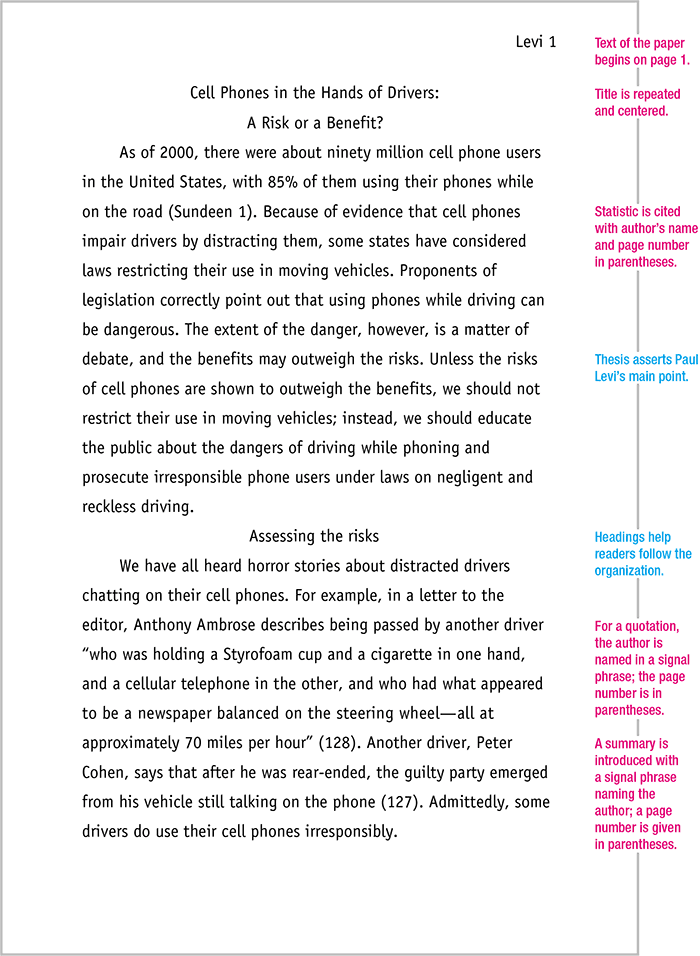
MLA Format Sample Paper, Page 1
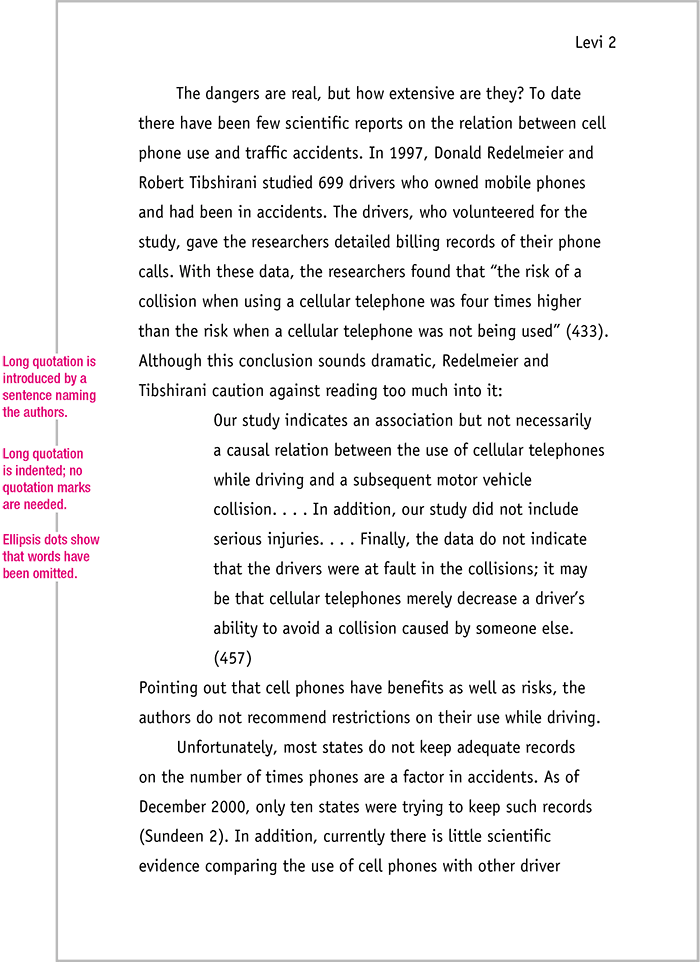
MLA Format Sample Paper, Page 2
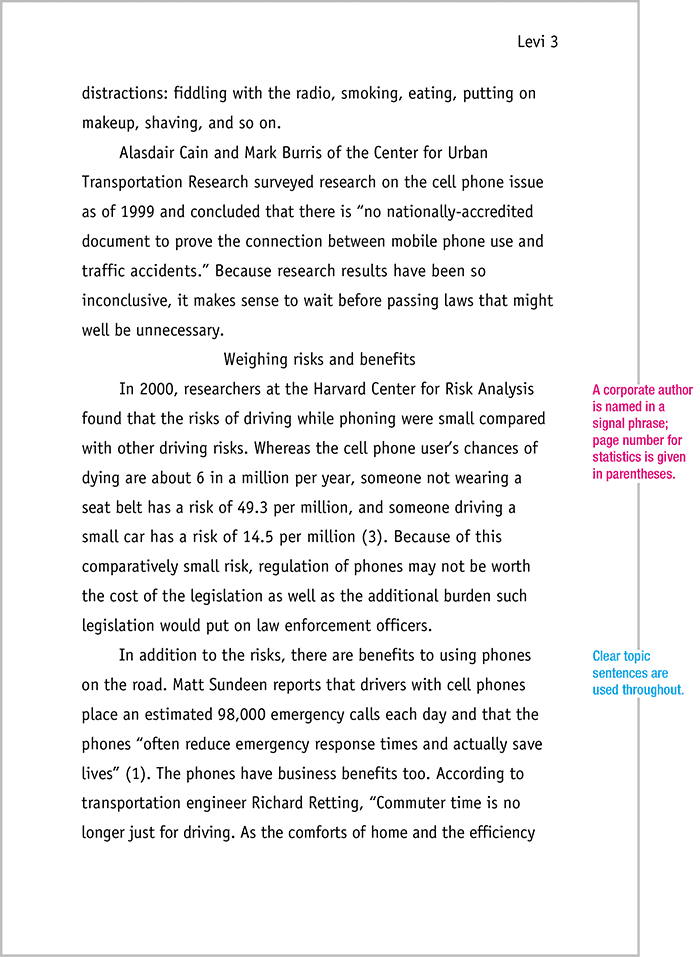
MLA Format Sample Paper, Page 3
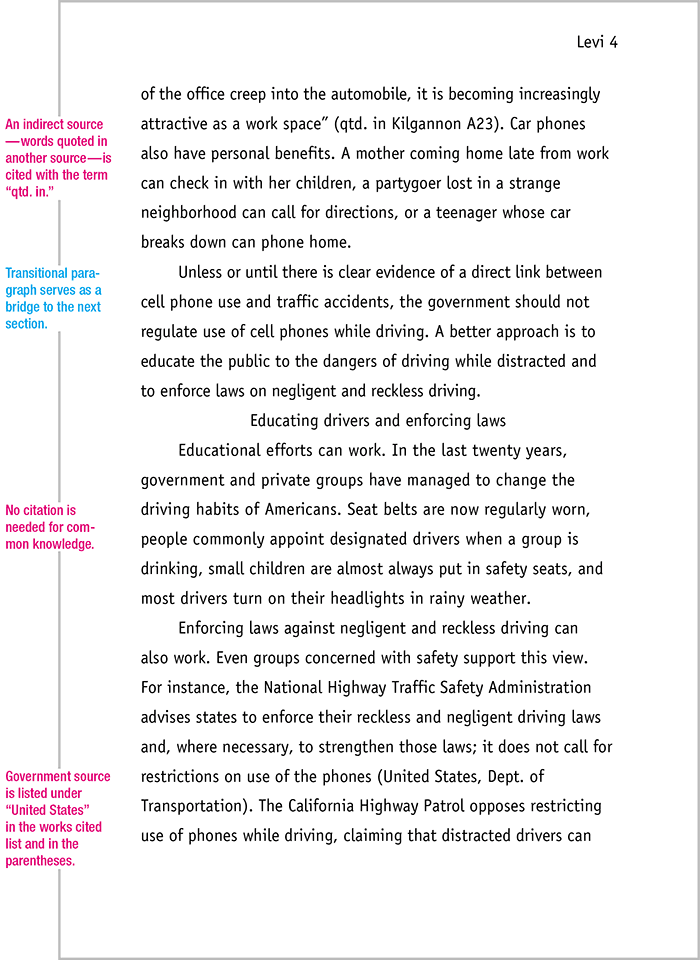
MLA Format Sample Paper, Page 4
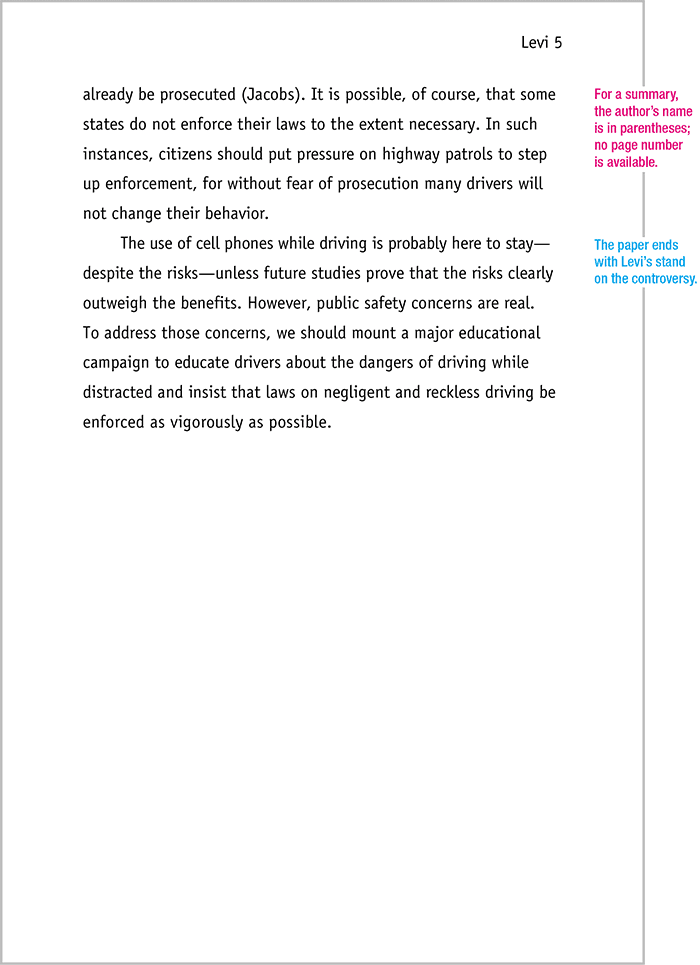
MLA Format Sample Paper, Page 5

MLA Format Sample Paper, Works Cited

MLA Format Sample Paper, End of Sample Paper.
– Diana Hacker (Boston: Bedford/St. Martin’s, 2006).
Very helpful information.
Intructions are clear in the begining.
Thank you, This will certainly help with assignments
I don’t care
Concise and easy to understand example. Thank you for your effort.
I am an older student returning to college and this helped me so much.
I didn’t have a clue what this format was, now I do. Thank you for your help.
Thank you for this resource; I am teaching MLA formatting to high school students and this will help with the “Why do we have to do it this way?!” questions. I just update them on the 8th edition changes.
The only way to achieve happiness is to cherish what you have and forget what you don’t have
thank you so much for your reference!
Thank you! I found your outline super helpful!
Awesome! Thank you so much. This information was so helpful. 🙂
Thank you so much. This is such a big help. God bless!
very helpful
Very helpful
thank yu its amazing helped me with assignments
Leave a Comment
Current ye ignore me @r *
Leave this field empty
Next post: APA Format Title Page
Previous post: MLA Format Sample Paper
- How to Format the Research Paper
- MLA Format Cover Page
- MLA Format Headings
- MLA Citations
- MLA Format Works Cited
- MLA Format Sample Paper
- MLA Sample Paper w/ Cover & Outline Pages
- MLA Format FAQs
- General Format of the APA Paper
- APA Format Title Page
- APA Format Abstract Page
- APA Headings
- APA Format Citations
- APA Reference Page
- APA Sample Paper
AcademicTips.org 1999–2024 • MLA Format • Privacy • Back to top ↑

- Warner Pacific University Library
- Research Guides
- MLA Formatting
Cover Page Example
Mla formatting: cover page example.
- Abstract Example
- In-Text Citations Example
- Block Quote Example
- Notes and Footnotes Page Example
- Annotated Bibliography Example
- Reference Page Example
- References for this MLA Document
University of Washington
Skin Canvas and Ink:
Tattooing as the Medium of Art in the Twenty-First Century
Janice Nehren
BIS 470: Mexican Art and Culture
Dr. Deborah Caplow
November 29th, 2015
First Page Example
November 29 th , 2015
With twenty-percent of adults, in 2012, having a tattoo, the tattoo industry is becoming one of the fastest growing of modern society (Greenblatt). And yet, even with these high numbers of individuals with tattoos, there are still many taboos relating to this form of art and several connotations made that still marginalize others. Culturally, research shows that tattoos are generally associated with bikers, gangs, criminal activity, prostitution, and even ignorance, often preventing people from obtaining jobs and moving up socially (Greenblatt). Often choosing to confine their tattoos and prevent as much visibility as possible, these individuals find themselves often discriminated against and feel as though they live double lives and in double standards; Dr. Lakra, a Mexican artist and tattoo artist from Oaxaca, Mexico, uses the medium of tattooing to challenge these social stigmas and present the trade of tattooing as an art form to the public that can be approached without social fear. Using photographs, postcards, and magazines between the early to mid-twentieth century, Dr. Lakra alters the original works by “tattooing” the figures in the frames to create works such as, Untitled (Films), Untitled (Maria Montez),Untitled (Emana), Untitled (Retrato de mujer con calaca), Untitled (1930), and Untitled (Símbolo de calidad); these works intentionally play with social juxtaposition through body modification.
...
Brain Food : MLA Guidelines in Writing
- MLA Google Document
- MLA PDF Document
- << Previous: How Do I Do: A Cover Page?
- Next: How Do I Do: An Abstract >>
- Last Updated: Sep 24, 2021 8:12 AM
- URL: https://guides.warnerpacific.edu/c.php?g=1035854

MLA Style: Basics
Formatting a paper in mla style, formatting specifications.
The MLA Style Center website has a great page that explains how to format a paper in MLA style. Their page, Formatting a Research Paper , explains how to format margins, text, headers and footers, page numbers, works cited, etc. Please consult the website and ask your professor to see how you should format your paper.
Sample Paper
The Academic Support Center also created a sample MLA paper This link opens in a new window .
- << Previous: Legal & Government
- Next: More Help Citing Sources in MLA >>

IMAGES
COMMENTS
How to Format Your MLA Cover Page: This page is double spaced and the letters are centered. Font: Times New Roman. Font size: 12. The first letter of each word should be capitalized with the exception of very short words such as: the, and, of, or, a, an, in, to, for. Note: the first letter of the first word should be capitalized, regardless of ...
Step-by-step instructions. Here are the steps you need to take to create the perfect MLA title page: At the top of the page, type the name of your high school, college, or university (if applicable). Skip down approximately one-third of the page and type the title of your research paper using title case.
To create an MLA format title page, list the following on separate lines, left-aligned at the top of the page: Then leave a few blank lines and list the title of the paper, centered and in title case, halfway down the page. All text should be double-spaced and in the same font as the rest of the paper. Note: If you're using a title page ...
Do not use a period after your title or after any heading in the paper (e.g., Works Cited). Begin your text on a new, double-spaced line after the title, indenting the first line of the paragraph half an inch from the left margin. Fig. 1. The top of the first page of a research paper.
Follow these steps to write a title page in MLA format: Launch Microsoft Word and open a blank document. Under the "File" menu, click on the "New" tab. Use the search bar and type "MLA" to find a sample template. Select the template that corresponds to your document type (research paper, essay, etc.). Check the preformatted document ...
This material may not be published, reproduced, broadcast, rewritten, or redistributed without permission. Use of this site constitutes acceptance of our terms and conditions of fair use. This resource contains a sample MLA paper that adheres to the 2016 updates. To download the MLA sample paper, click this link.
1 Place the page number (always 1) in the upper-right corner of the page, flush right with the one-inch page margin. This is part of the running head that goes on every page in APA format, although for student papers this header only includes the page number. 2 Three or four lines down (double-spaced) from the top page margin, write the paper ...
How to Format Your MLA Cover Page: This page is double spaced and the letters are centered. Font: Times New Roman. Font size: 12. The first letter of each word should be capitalized with the exception of very short words such as: the, and, of, or, a, an, in, to, for. Note: the first letter of the first word should be capitalized, regardless of ...
A title page is on its own page before the main paper copy, centers the text, and spreads the text throughout the title page. An MLA heading appears on the same page on which the main paper copy starts, the heading is aligned to the left, and it only appears at the top of the page. For more information on how to create headings, refer to the ...
MLA cover page requirements. 1 inch margins on all sides. Easily readable typeface (like Times New Roman), 11 or 12 points. Double-spacing throughout the paper. A header in the upper right-hand corner: give your last name, followed by a space with the page number. This should be included on all pages, one-half inch from the top.
MLA Title Page Format. The MLA format cover page is not an entirely separate page. It begins with a 1-inch margin, flush left with your name, your instructor's name, the course name or number, and the date typed on separate, double-spaced lines. The title of your research paper should then be centered on the MLA format title page.
Type your paper on a computer and print it out on standard, white 8.5 x 11-inch paper. Double-space the text of your paper and use a legible font (e.g. Times New Roman). Whatever font you choose, MLA recommends that the regular and italics type styles contrast enough that they are each distinct from one another.
MLA (Modern Language Association) style is most commonly used to write papers and cite sources within the liberal arts and humanities. This resource, updated to reflect the MLA Handbook (9th ed.), offers examples for the general format of MLA research papers, in-text citations, endnotes/footnotes, and the Works Cited page.
3. Leave 2-3 lines. 4. Write the course or class information. You may want to include the section number as well as the name of the course. 5. Write the instructor's name on the next line. Be sure to include the appropriate title, particularly if your instructor has a doctorate.
Cite your MLA source. Start by applying these MLA format guidelines to your document: Use an easily readable font like 12 pt Times New Roman. Set 1 inch page margins. Use double line spacing. Include a ½" indent for new paragraphs. Include a four-line MLA heading on the first page. Center the paper's title.
Heading and Title. An MLA research paper does not need a title page, but your instructor may require one. If no instructions are given, follow the MLA guidelines below: Type the following one inch from the top of the first page, flush with the left margin (double spacing throughout). Your Name. Your Instructor's Name. Course Number or Name. Date.
MLA Style Center, the only authorized Web site on MLA style, provides free resources on research, writing, and documentation.
This is a brief tutorial demonstrating how to format a cover page in Microsoft Word using the 8th edition of MLA Format.
Formatting the First Page. Since you're not required to provide a separate cover page, you'll need to place your name, the teacher's name, the course and the date on the top of the first page. Include the page number on the first page, following these guidelines: 0.5 inches from the top. Right-justified. Your last name and page number.
Here is a sample paper in MLA format that has both the cover page and the outline pages. This paper has 10 pages so if you are under a slow Internet connection, please wait a few seconds for all of the pages to load. This paper is current with the latest MLA manual. MLA Format Sample Paper, Title Page. MLA Format Sample Paper, Outline Page 1.
First Page Example. Nehren 1. Janice Nehren. Dr. Deborah Caplow. BIS 470: Mexican Art and Culture. November 29 th, 2015. Skin Canvas and Ink: Tattooing as the Medium of Art in the Twenty-First Century. With twenty-percent of adults, in 2012, having a tattoo, the tattoo industry is becoming one of the fastest growing of modern society (Greenblatt).
Formatting Specifications. The MLA Style Center website has a great page that explains how to format a paper in MLA style. Their page, Formatting a Research Paper, explains how to format margins, text, headers and footers, page numbers, works cited, etc.Please consult the website and ask your professor to see how you should format your paper.